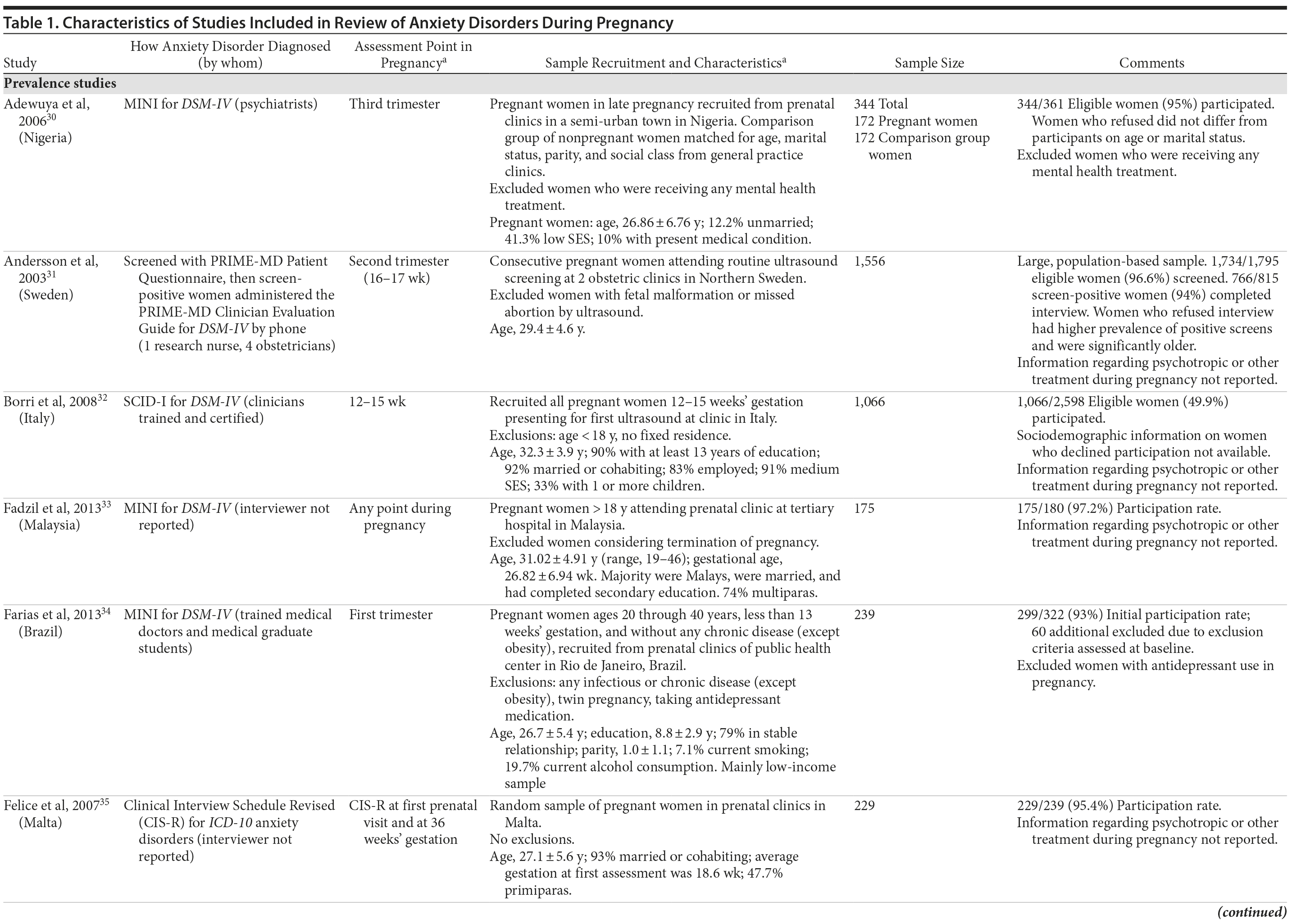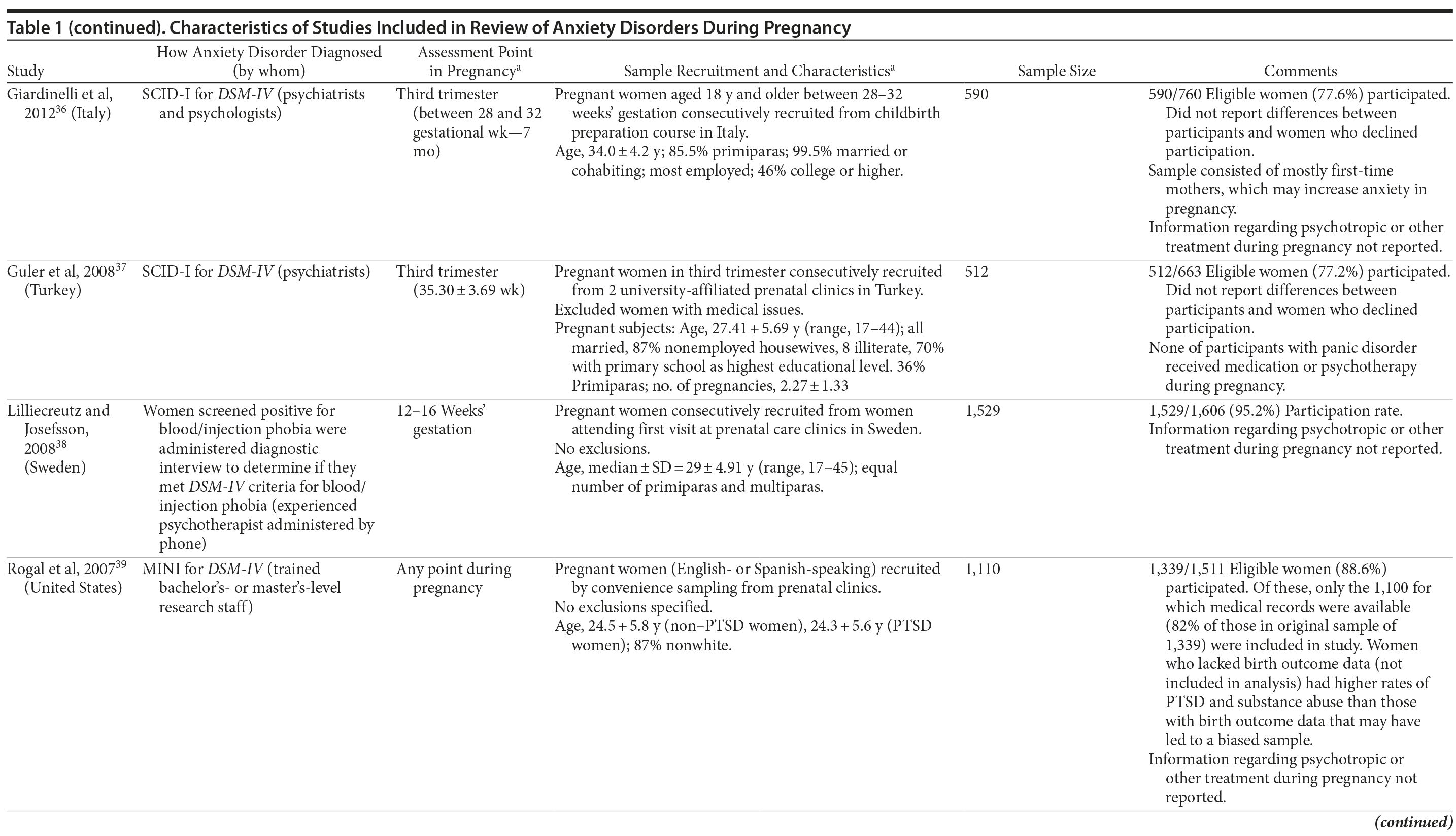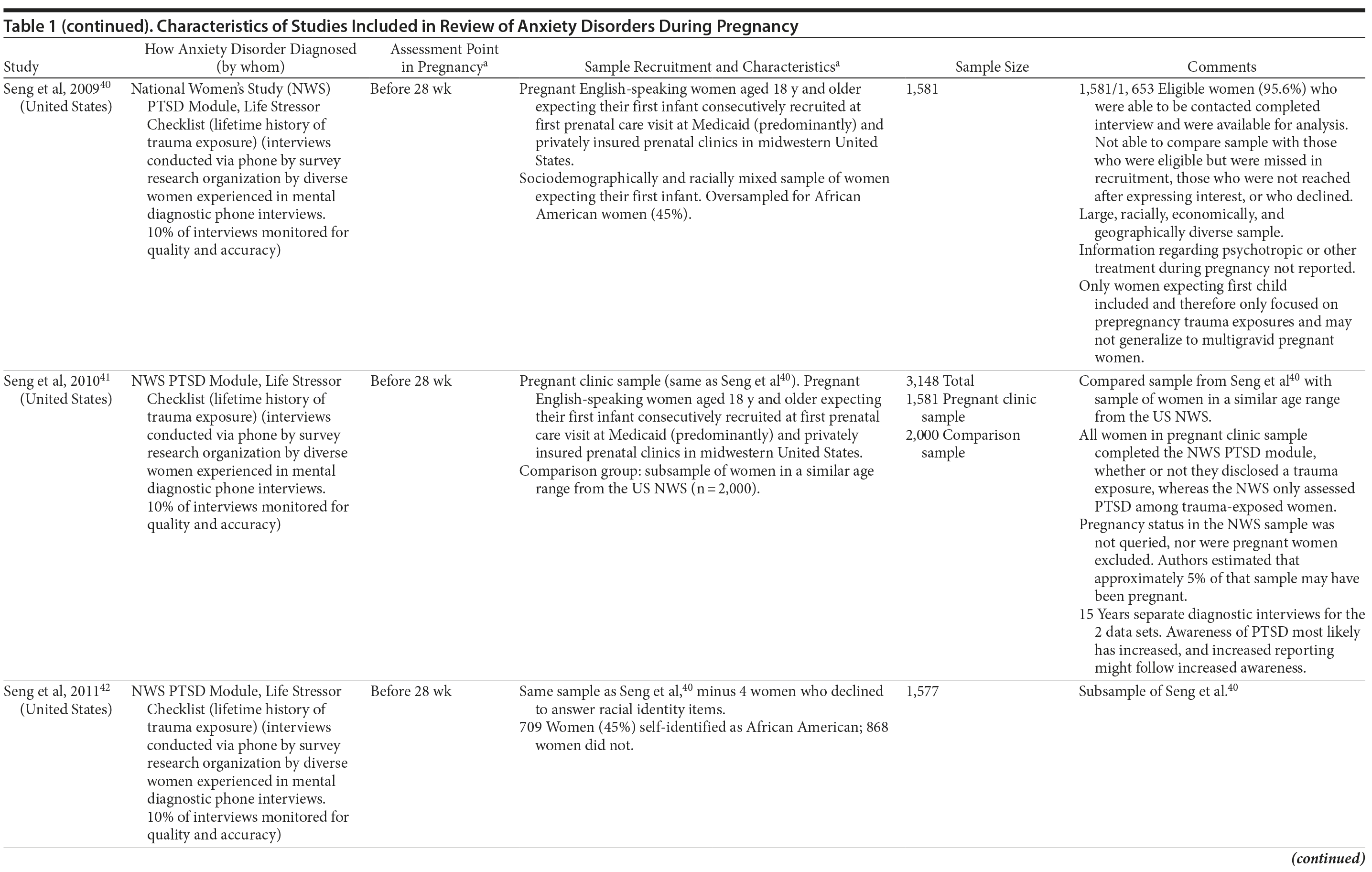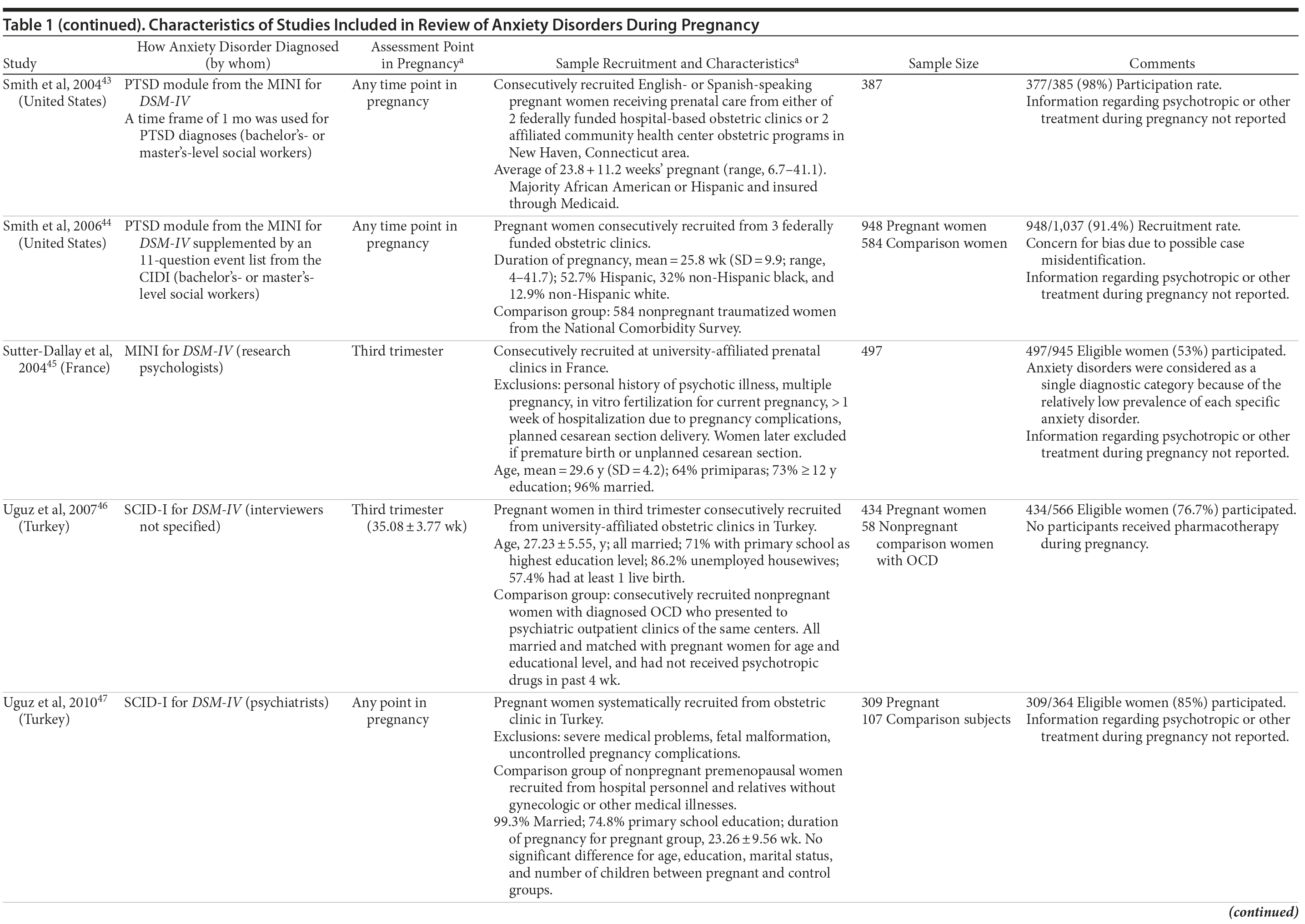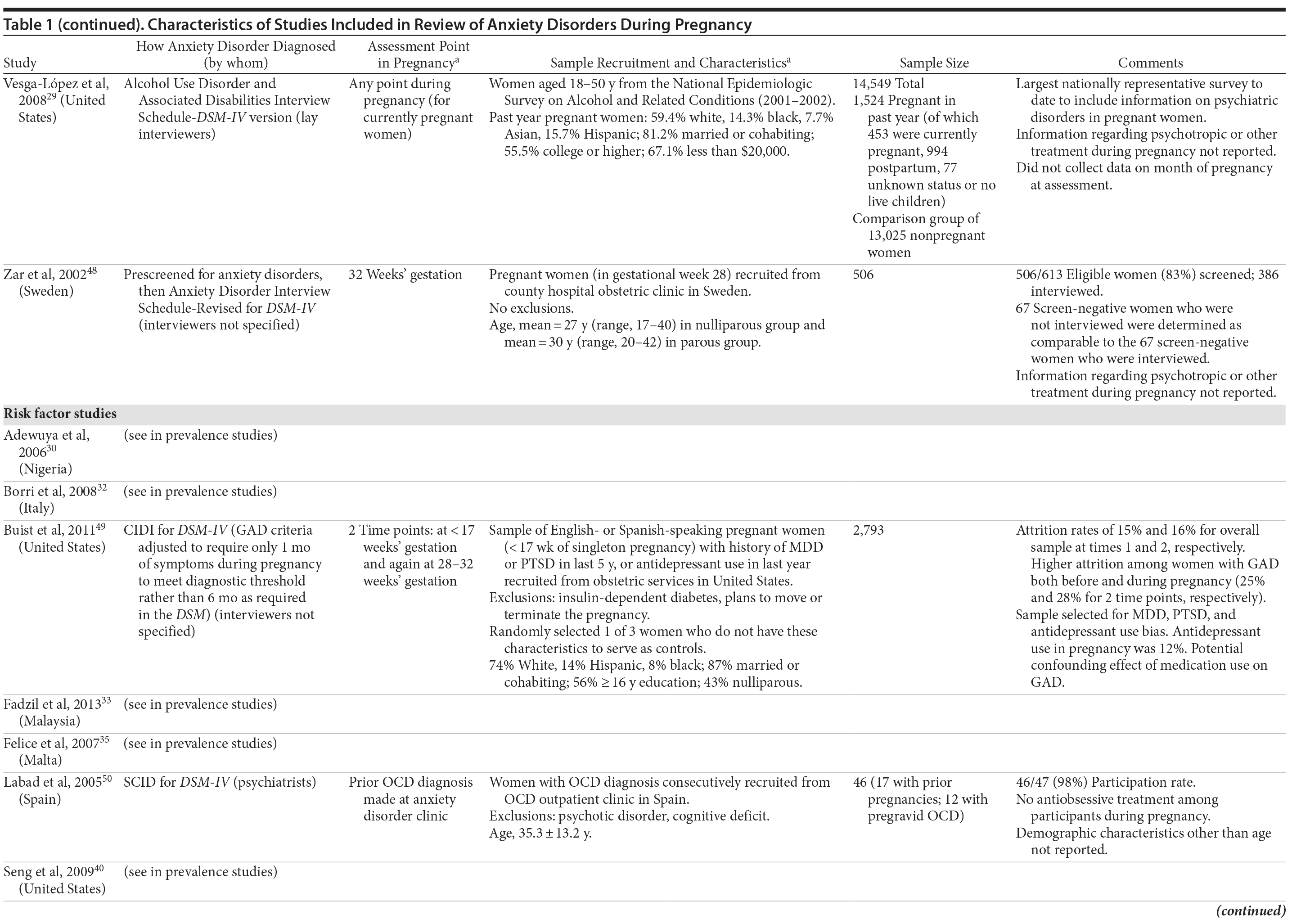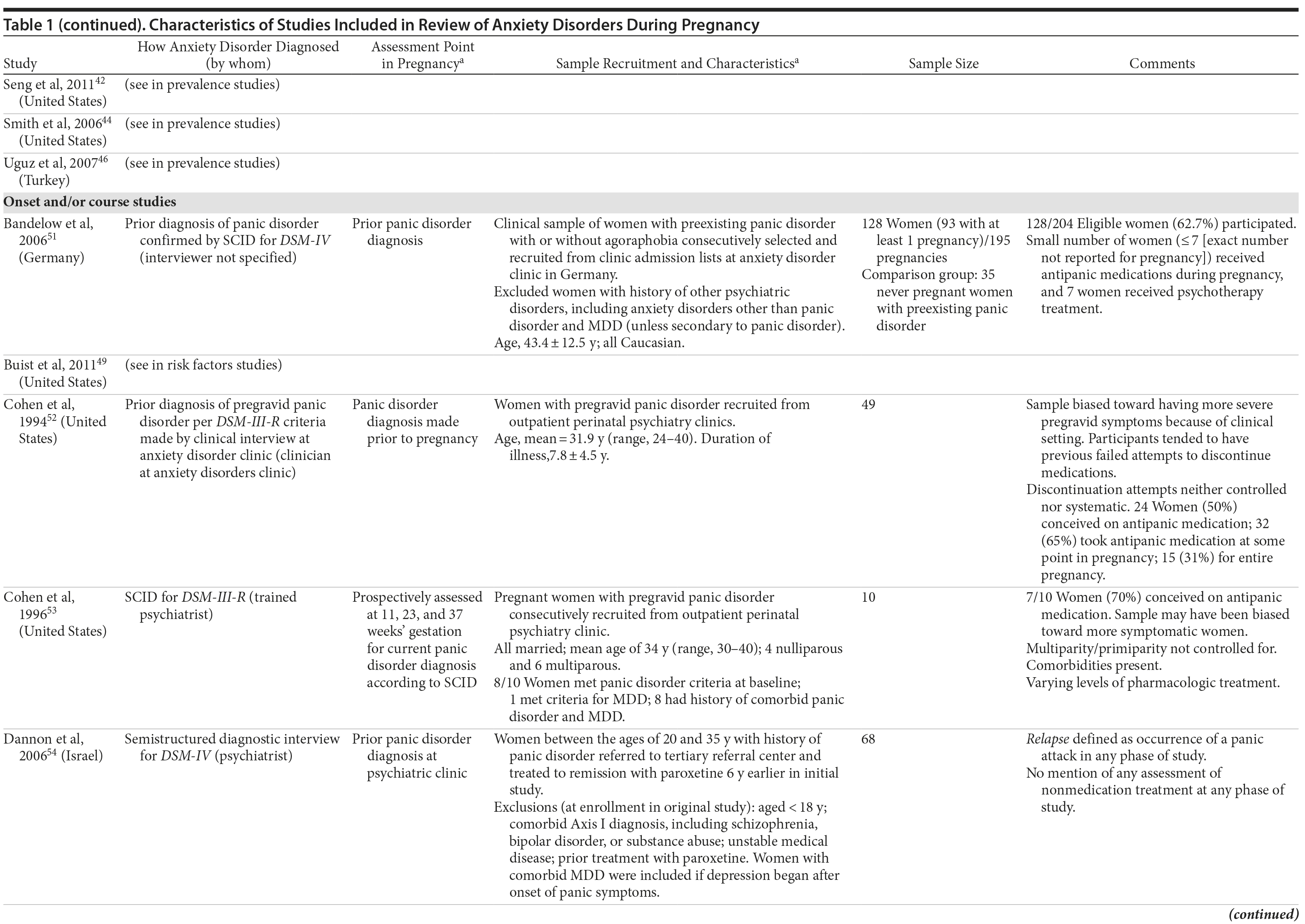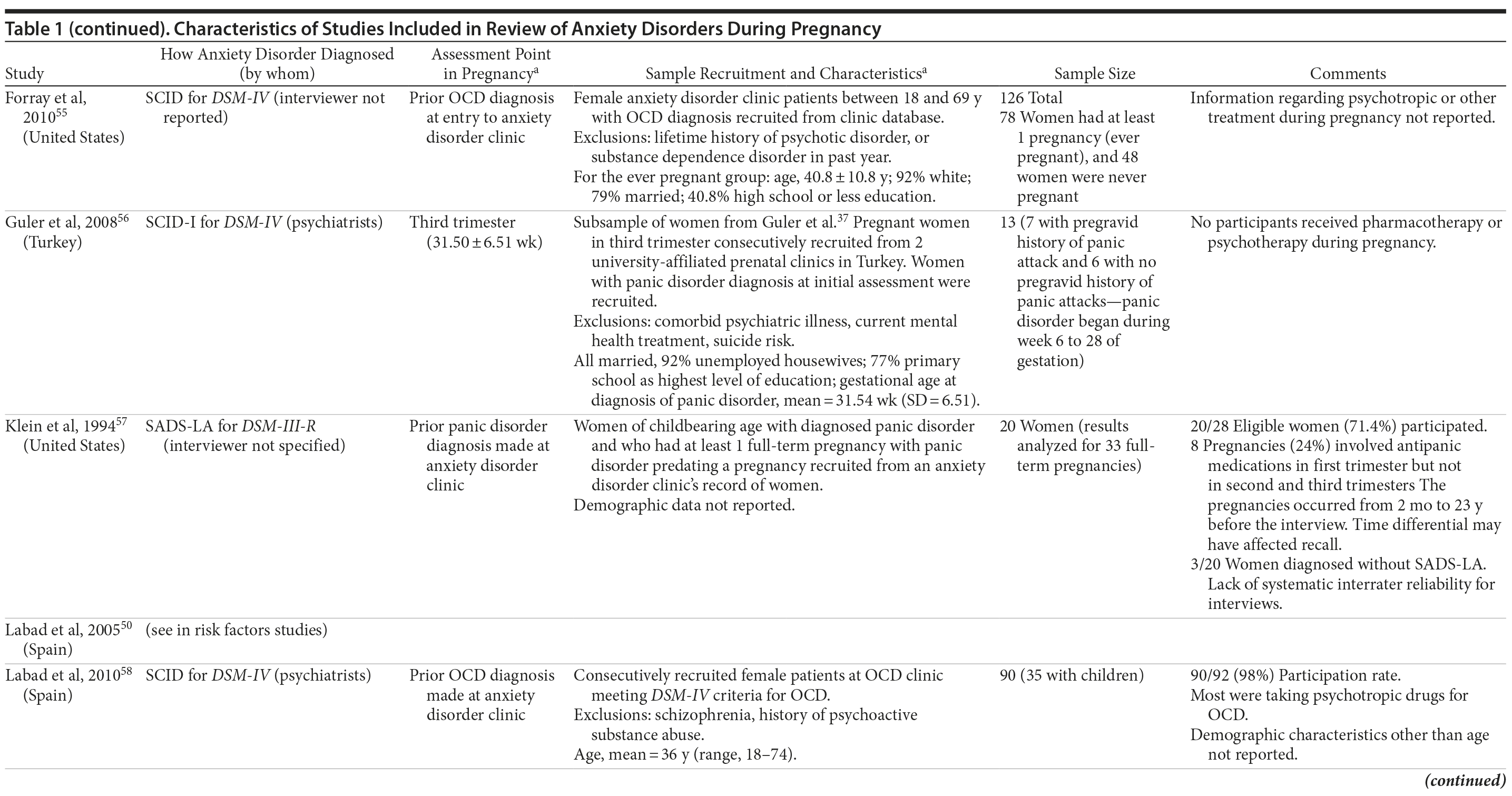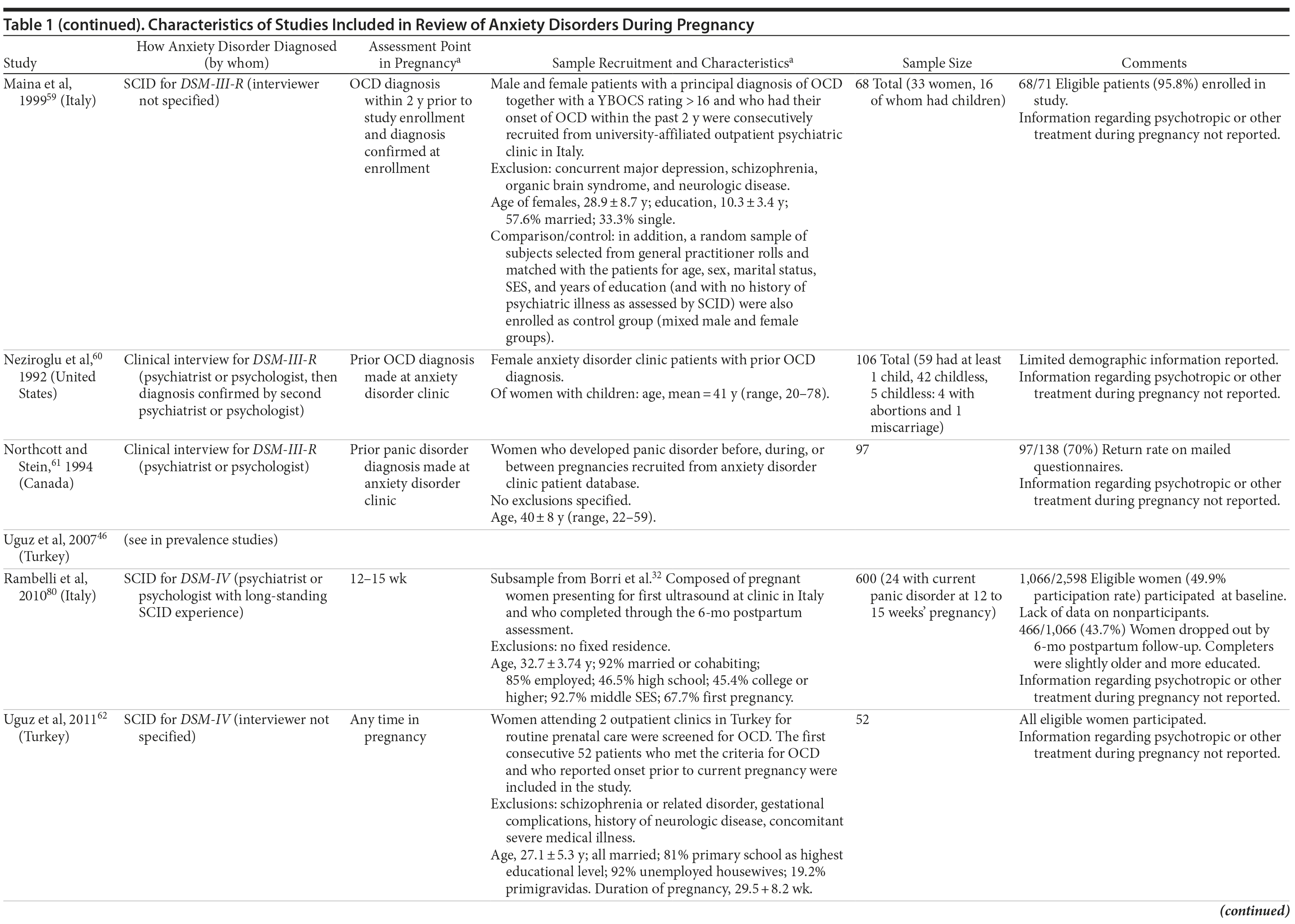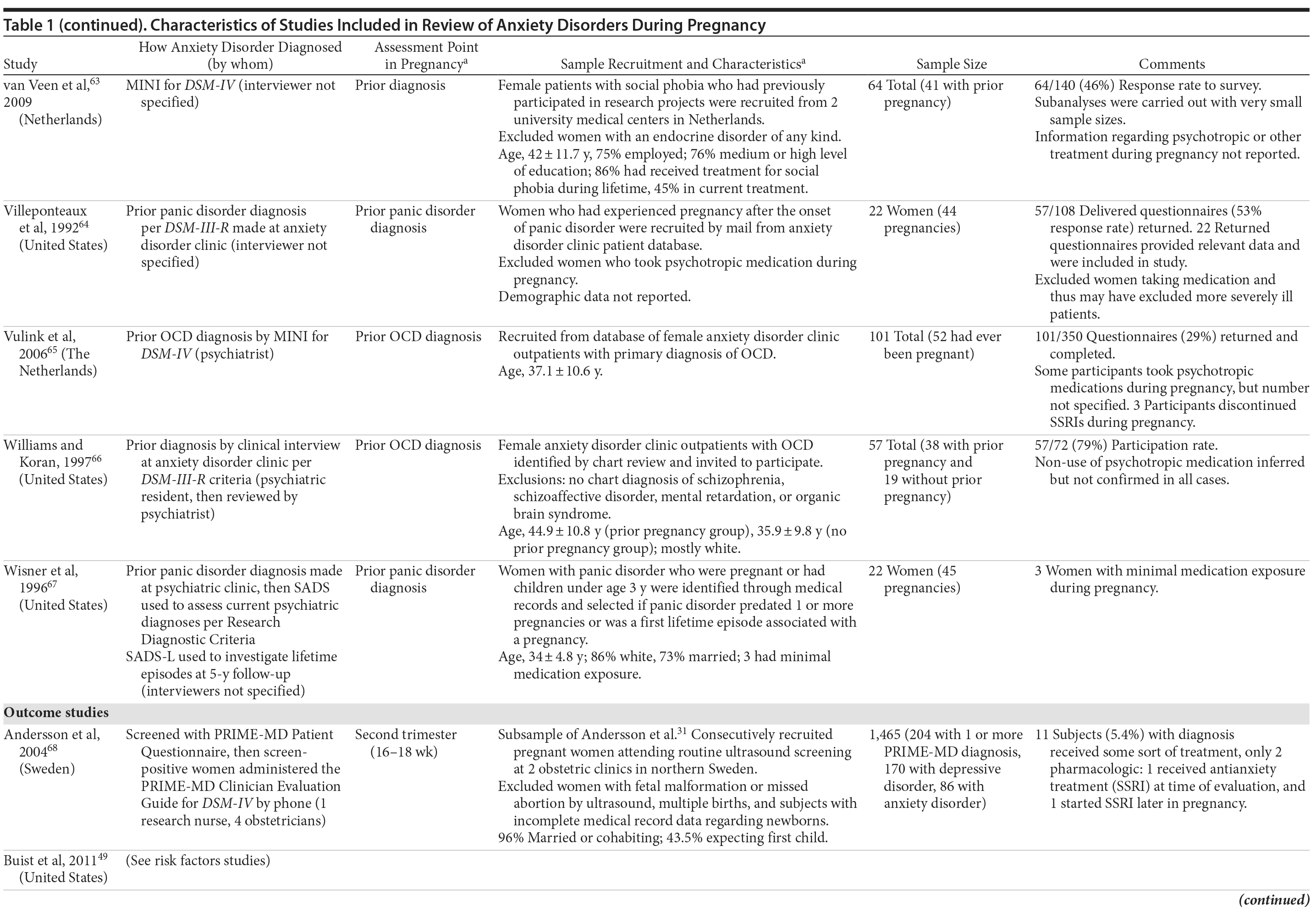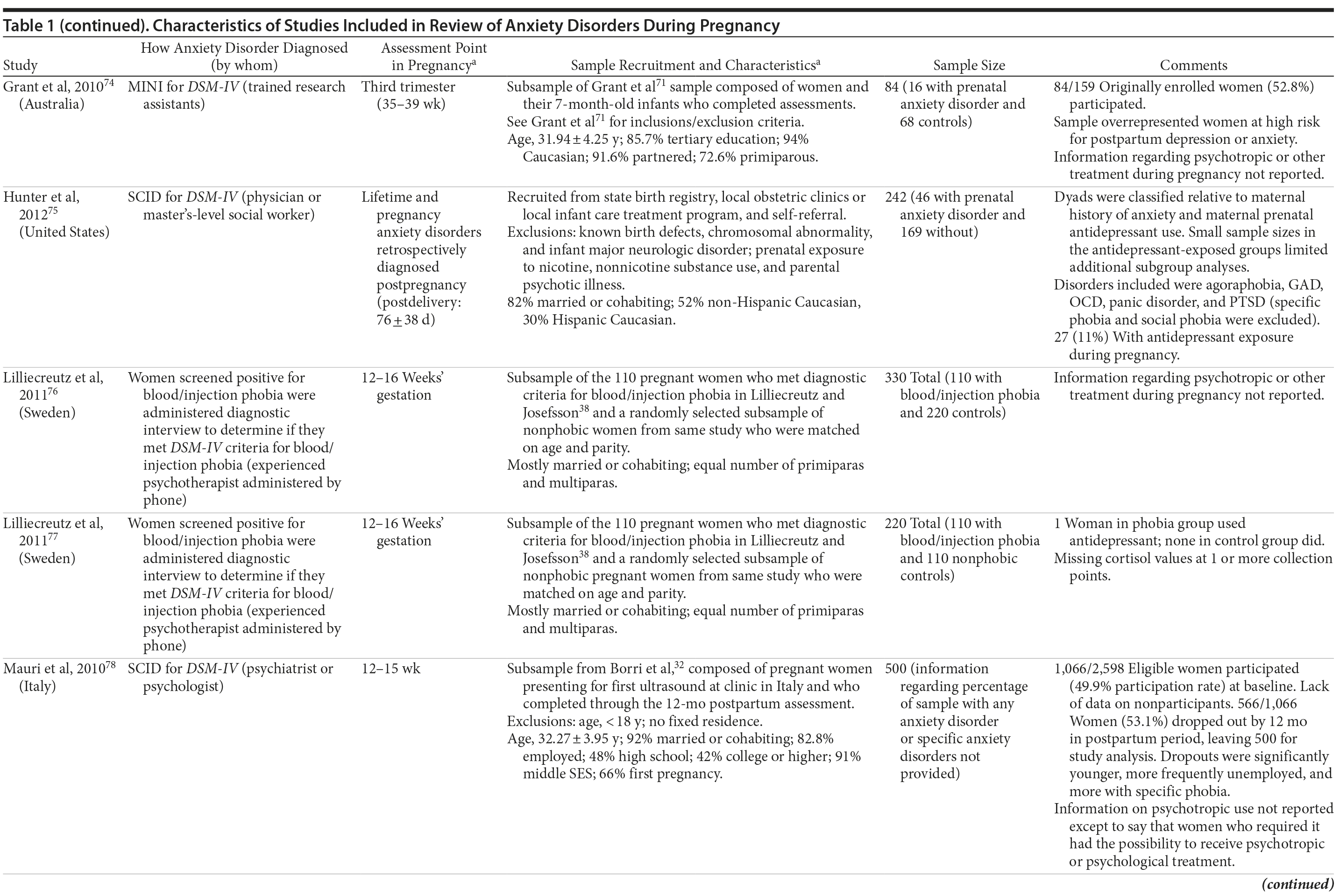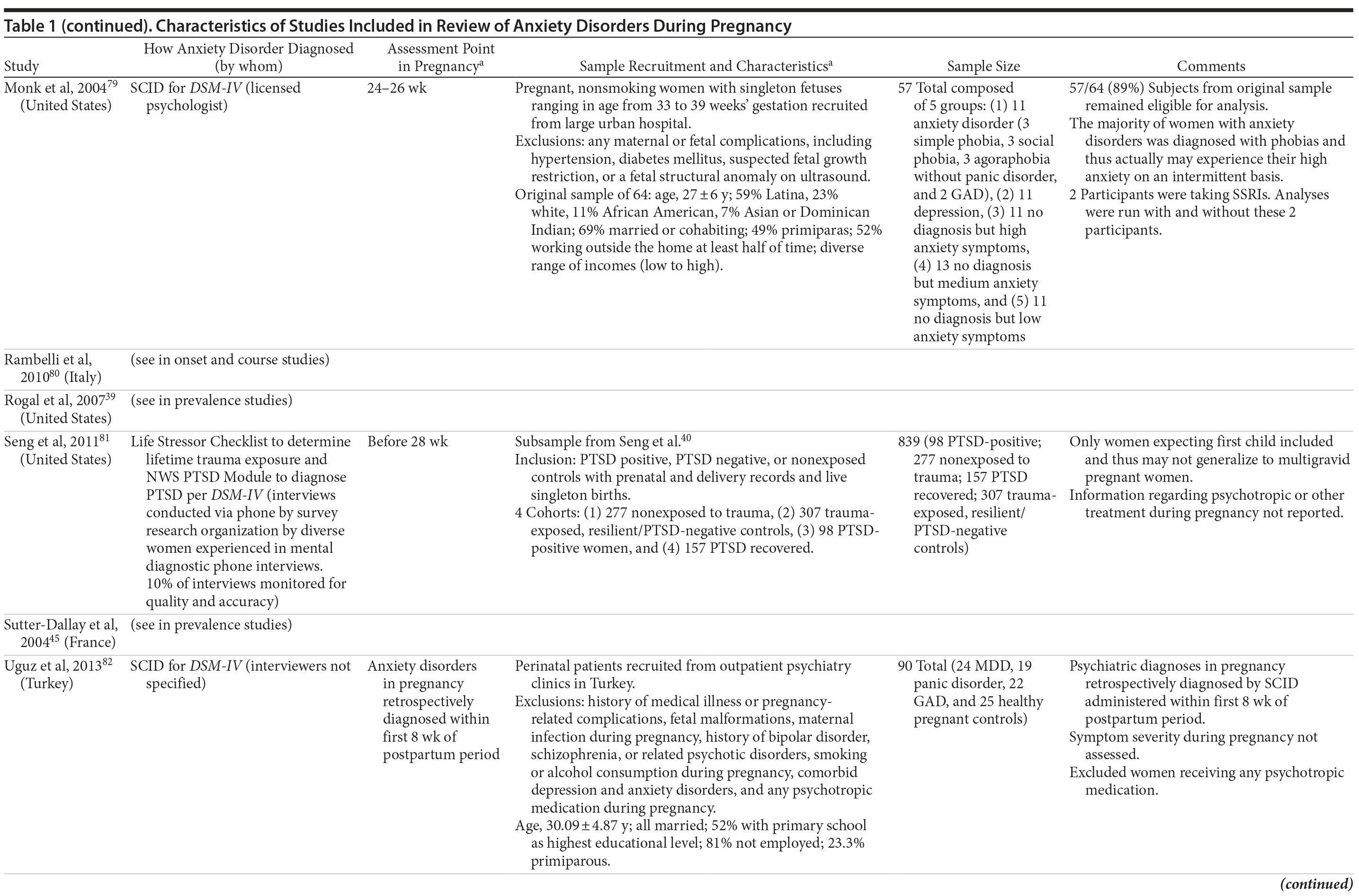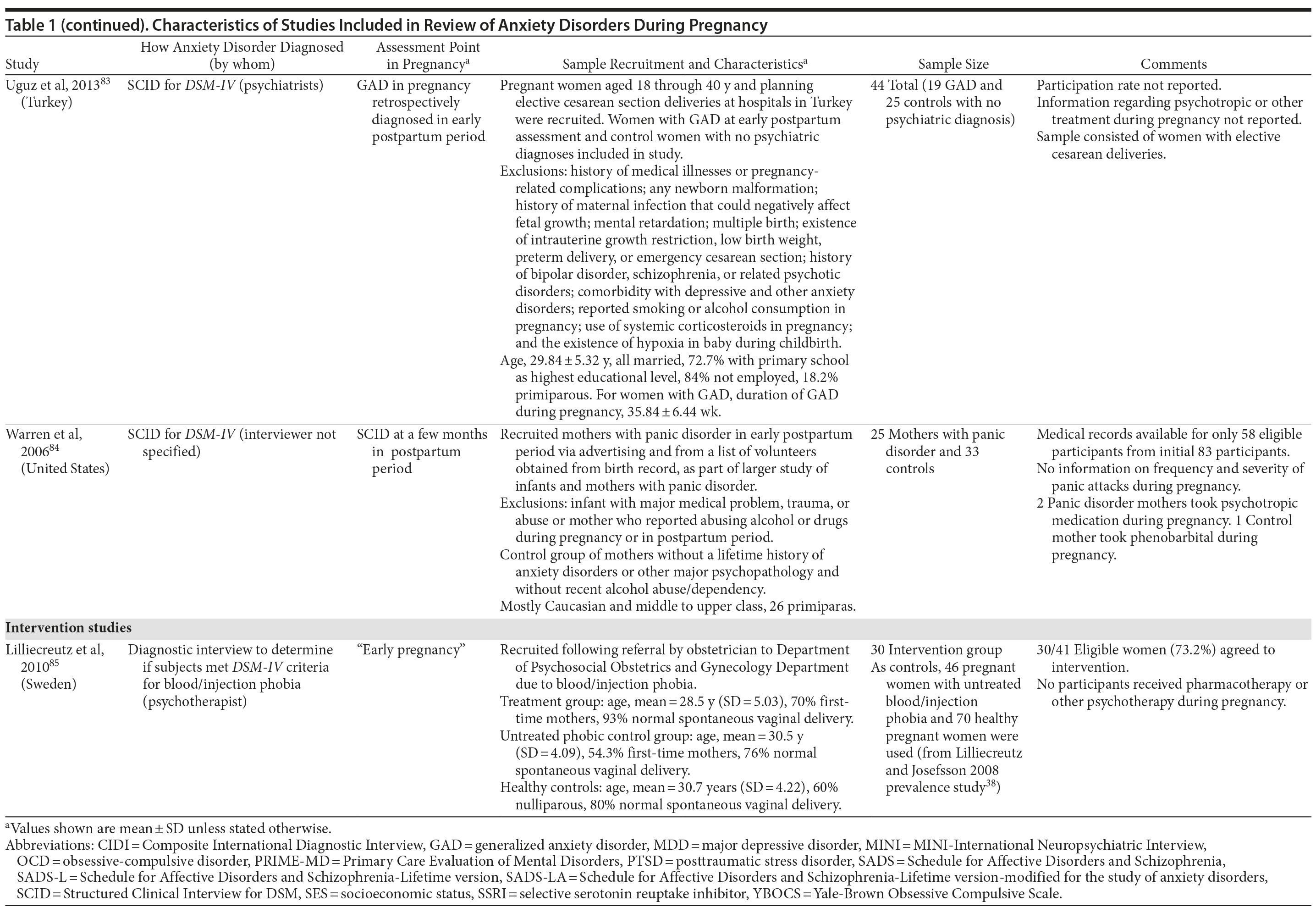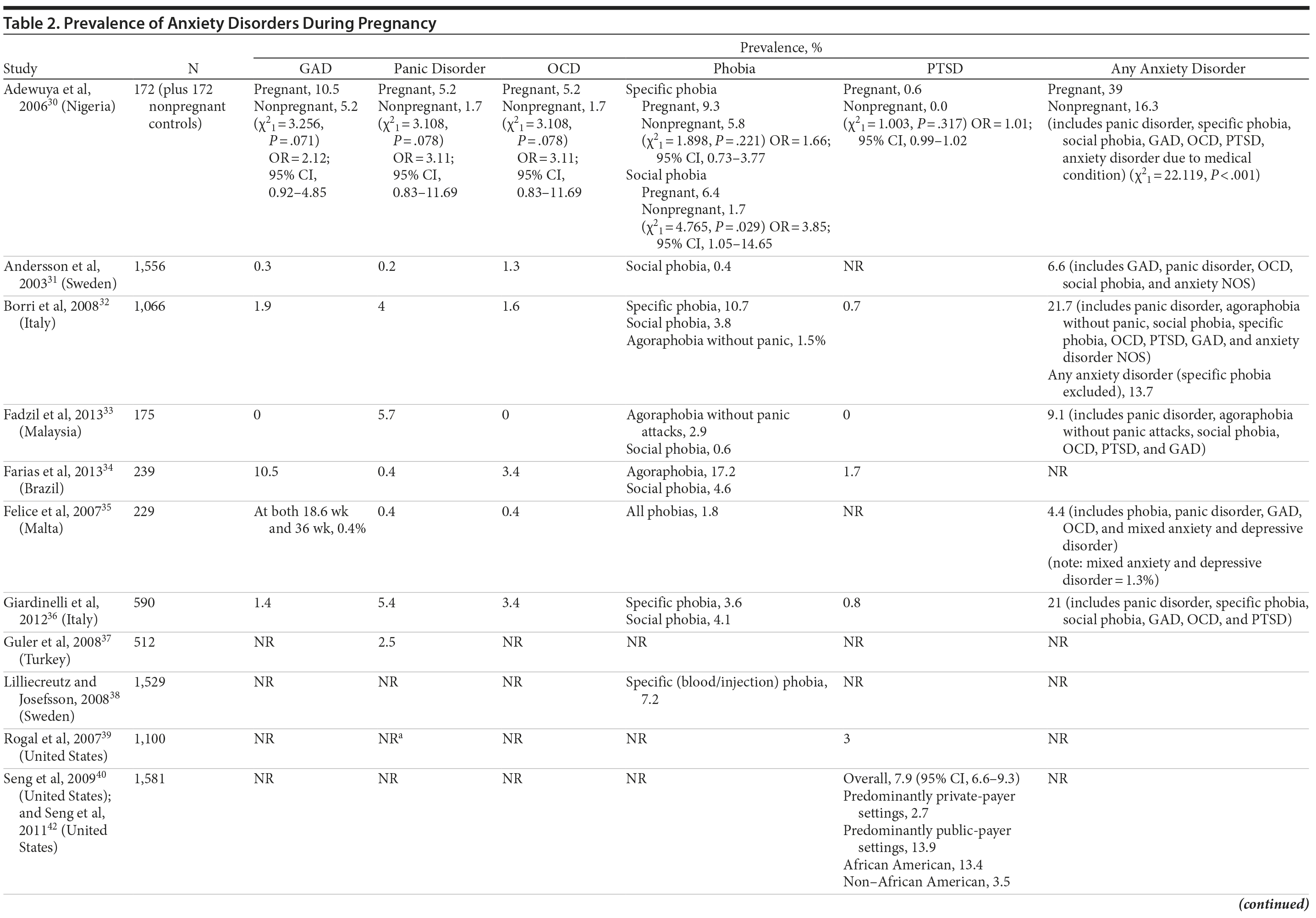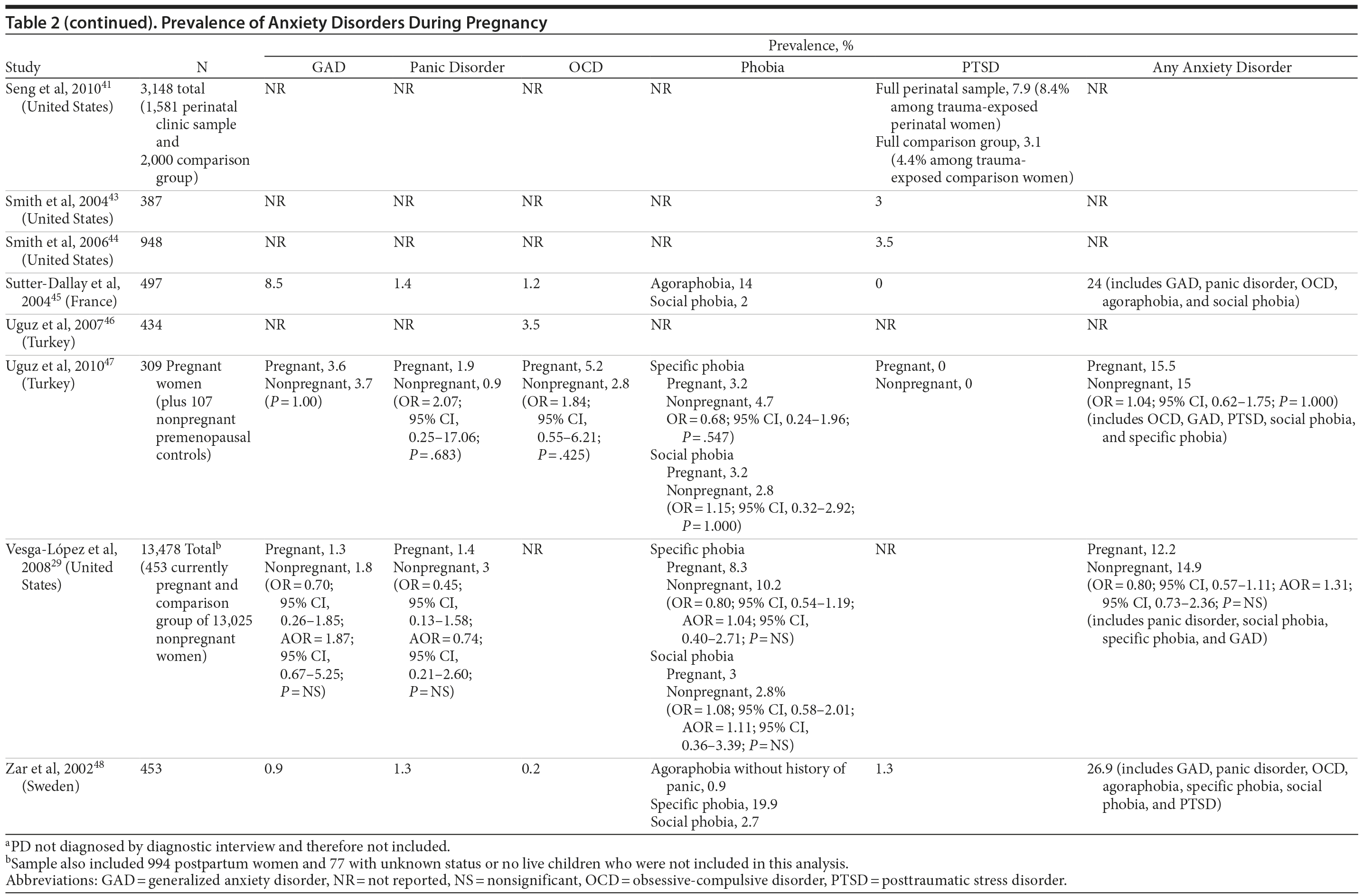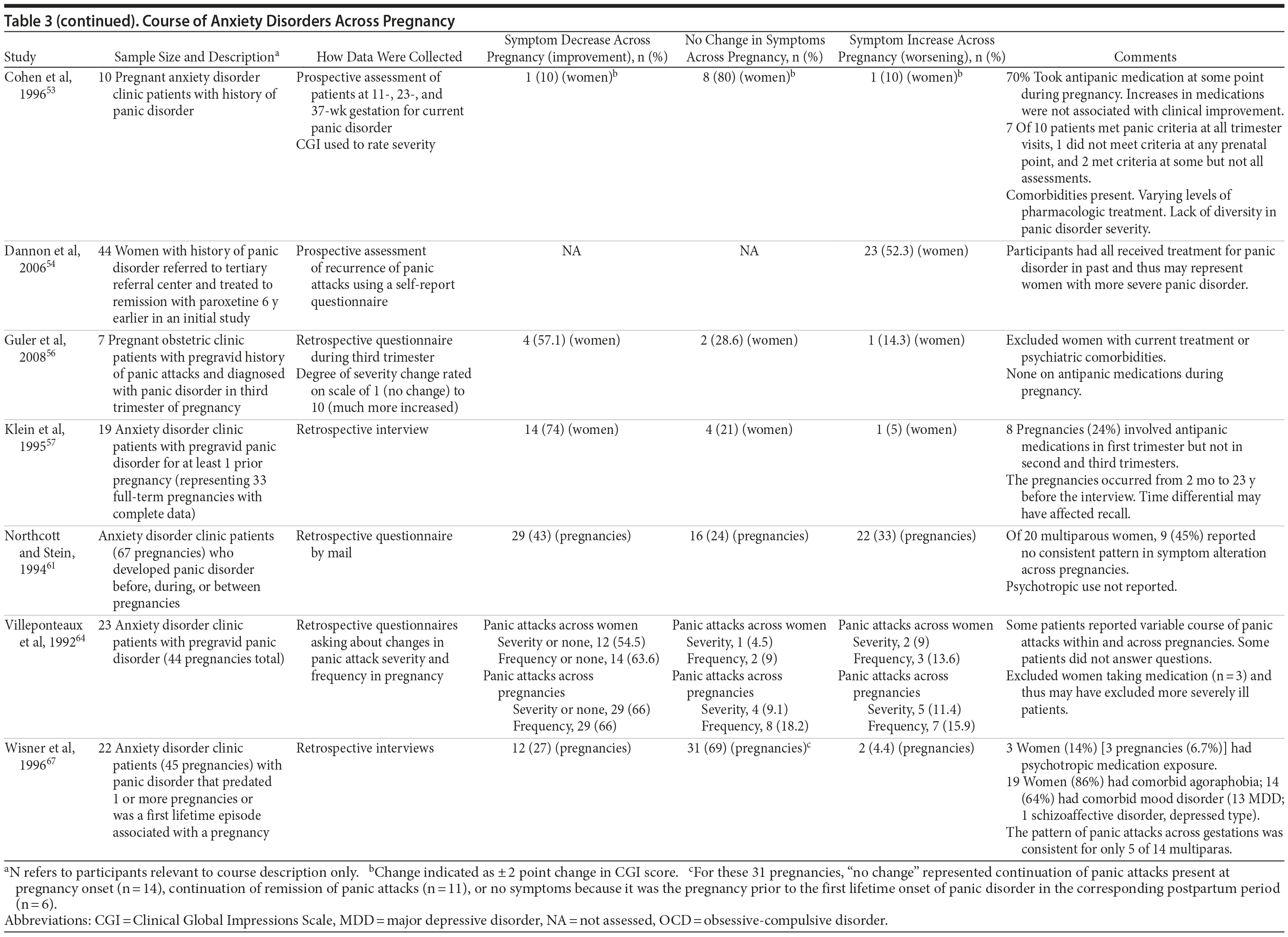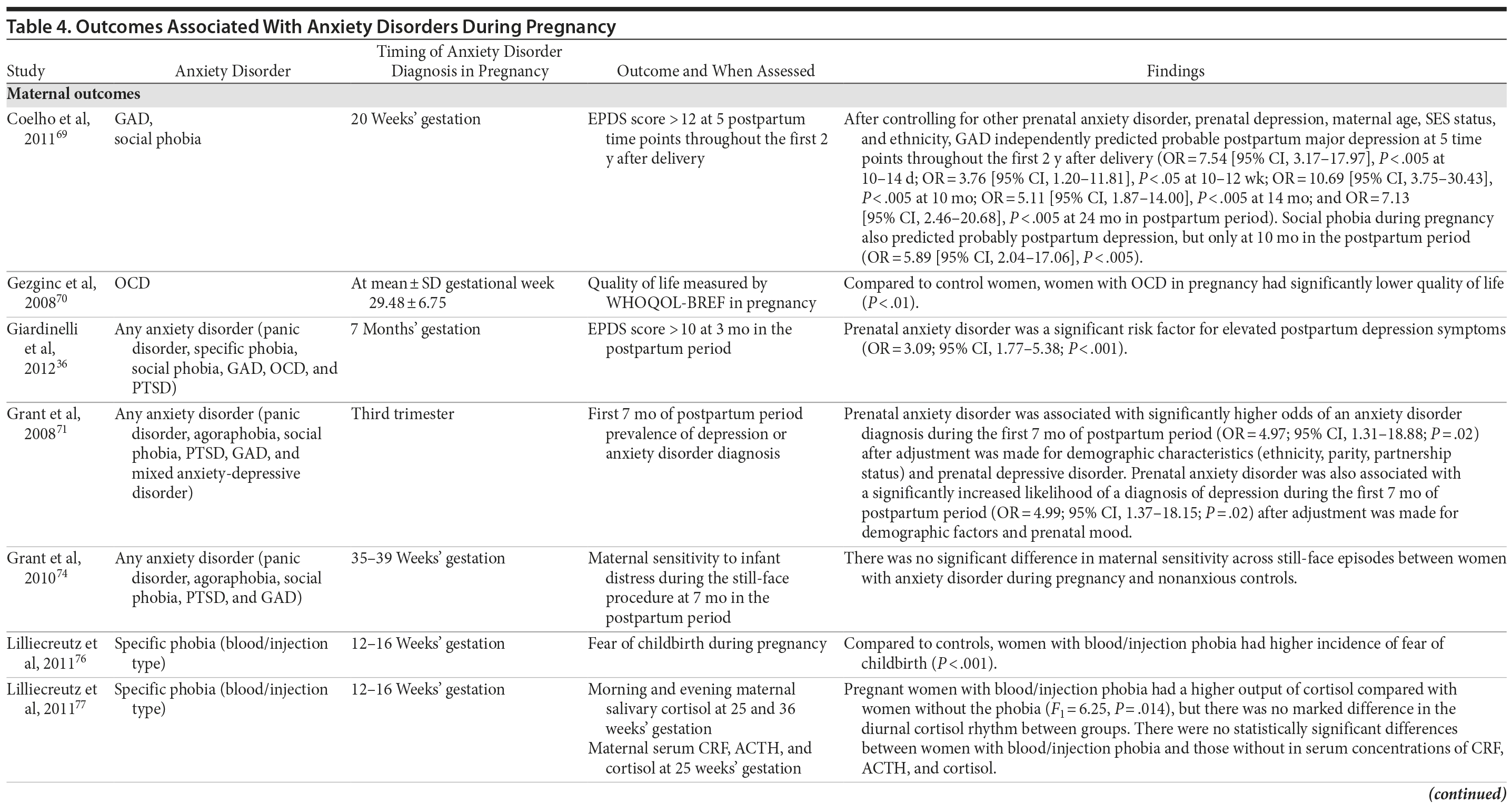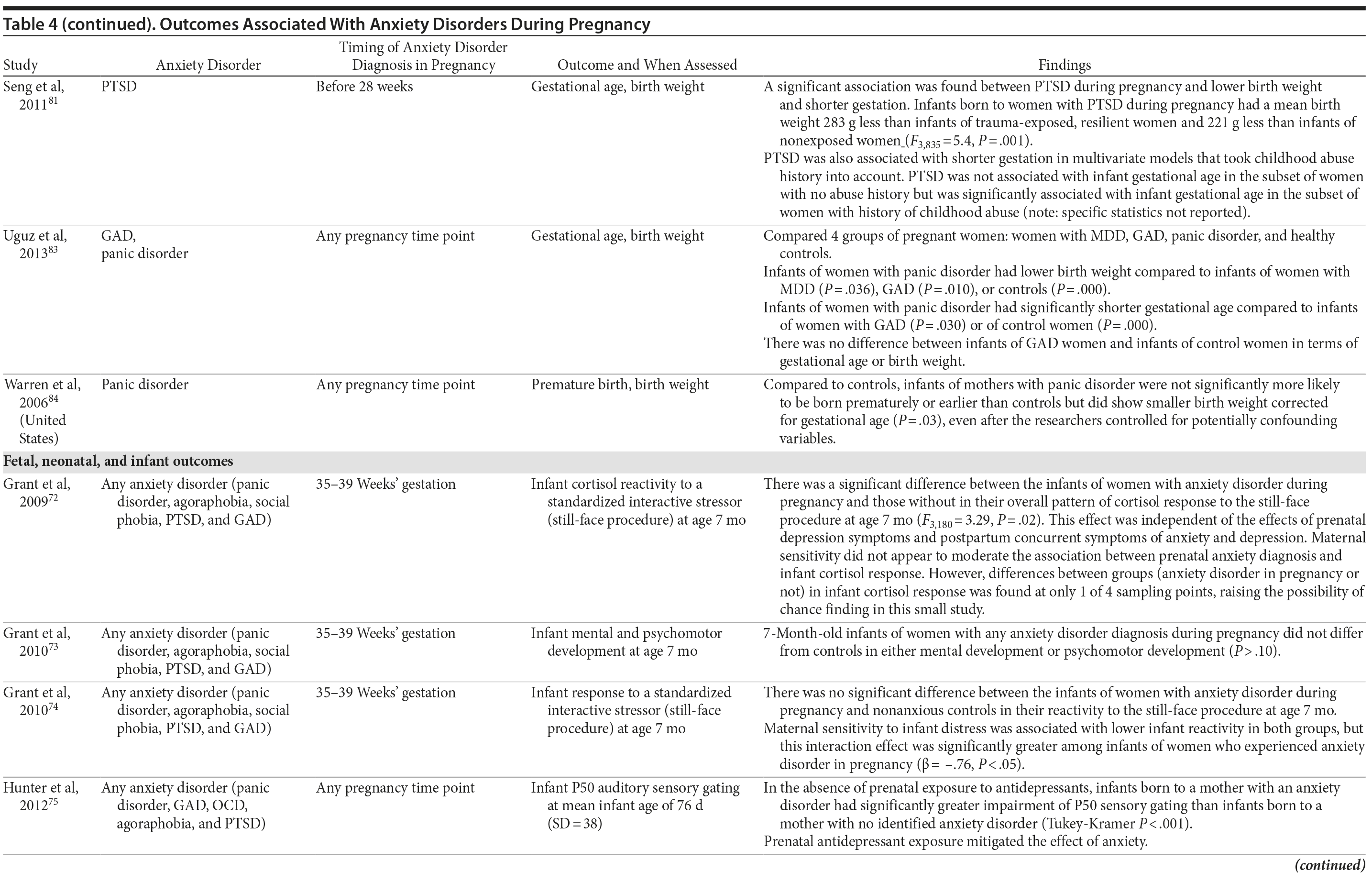
Anxiety Disorders During Pregnancy: A Systematic Review

ABSTRACT
Objective: To systematically evaluate the literature on anxiety disorders during pregnancy.
Data Sources: MEDLINE, PsycINFO, and CINAHL were searched through October 2013 for original research studies published in English using combinations of the terms pregnancy, prenatal, or pregnancy outcomes; anxiety disorder; and generalized anxiety. Reference lists of included studies were hand-searched and a PubMed search for in-process reports was conducted.
Study Selection: Relevant studies of anxiety disorders during pregnancy as determined by diagnostic interview were included if they reported on prevalence; course, onset, and/or risk factors; maternal, obstetric, or fetal/child outcomes; and/or treatment trial results.
Data Extraction: Two reviewers independently extracted relevant data and assessed methodological quality of each study.
Results: Fifty-seven reports were included. Reports provided information on panic disorder (25 reports), generalized anxiety disorder (17 reports), obsessive-compulsive disorder (OCD) (23 reports), agoraphobia (6 reports), specific phobia (10 reports), social phobia (14 reports), posttraumatic stress disorder (14 reports), and any anxiety disorder (18 reports). Twenty reports provided information on prevalence, 16 on course, 10 on risk factors, and 22 on outcomes. Only 1 treatment study was identified. High anxiety disorder prevalence in pregnancy was found; however, estimates vary considerably, and evidence is inconclusive as to whether prevalence among pregnant women differs from that of nonpregnant populations. Considerable variation in prenatal course of OCD and panic disorder was found. Substantial heterogeneity limits conclusions regarding risk factors or outcomes.
Conclusions: Additional research of higher methodological quality is required to more accurately determine prevalence, understand course, identify risk factors and outcomes, and determine effective treatments for anxiety disorders in pregnancy.
J Clin Psychiatry 2014;75(10):e1153-e1184
© Copyright 2014 Physicians Postgraduate Press, Inc.
Submitted: February 3, 2014; accepted May 13, 2014 (doi:10.4088/JCP.14r09035).
Corresponding author: Janice H. Goodman, PhD, RN, MGH Institute of Health Professions, School of Nursing, 36 1st Ave, Boston, MA 02129 ([email protected]).
Anxiety disorders are diagnosed nearly twice as often in women compared to men.1-3 Approximately 30% of women will experience an anxiety disorder during their lifetime. Given their relatively early onset and often chronic course, anxiety disorders are experienced by many women during pregnancy.
High rates of anxiety symptoms have been reported among pregnant women.4-7 Several studies suggest that the prevalence of anxiety symptoms may be higher during pregnancy than in the postpartum period5-8 and may be more common during pregnancy than depression.5 However, the prevalence of anxiety disorders during pregnancy remains unclear. In order to plan effective services, accurate prevalence estimates are needed. Furthermore, identifying women most at risk for anxiety disorders in pregnancy is important so targeted prevention and early intervention can be implemented. Although several meta-analyses9-12 have summarized risk factors for postpartum depression and, more recently, a review13a of risk factors for depression in pregnancy appeared in the literature, there has been no systematic synthesis of the literature regarding risk factors for anxiety disorders during pregnancy. Understanding the pregnancy course of preexisting anxiety disorders also has implications for risk determination and management of anxiety disorders during pregnancy.
Research indicates a link between prenatal maternal stress and anxiety and adverse obstetric, fetal, and neonatal outcomes.13b-19 Most of the research in this area has focused on anxiety symptoms—usually determined by self-report or rating scales—rather than on clinically diagnosed anxiety disorders. Anxiety meeting levels of clinical disorders is particularly relevant, representing the most severe, persistent anxiety, which would impact functioning and, potentially, pregnancy outcomes and fetal and child outcomes. Identification of negative consequences associated with prenatal anxiety disorders has important implications for pregnant women and those planning pregnancy with histories of anxiety disorders. Identification of safe and effective treatments for use during pregnancy is imperative to ameliorate adverse consequences for mother and child.
Ross and McLean20 provided the first research review of perinatal anxiety disorders, covering the published literature up to early 2005, and concluded that there is a paucity of quality research evidence in this topic area. The purpose of the current review is to provide a comprehensive, systematic, and up-to-date evaluation of the literature on anxiety disorders during pregnancy.
OBJECTIVES
A systematic review of relevant published studies was conducted to answer the following questions:
- How common are anxiety disorders during pregnancy?
- Does pregnancy have an effect on the onset and course of anxiety disorders?
- Are there known risk factors for anxiety disorders in pregnancy?
- Are there known maternal, obstetrical, or child outcomes associated with anxiety disorders during pregnancy?
- What are the evidence-based treatments for anxiety disorders during pregnancy?
DATA SOURCES
This study was conducted by using the Preferred Reporting Items for Systematic Reviews and Meta-Analyses (PRISMA) guidelines and checklist.21 Anxiety disorders considered in the review included generalized anxiety disorder (GAD), panic disorder, obsessive-compulsive disorder (OCD), phobias, and posttraumatic stress disorder (PTSD).
In consultation with an experienced research librarian, relevant published research articles were identified by a systematic search of the following databases from their inception through October 2013: MEDLINE, PsycINFO, and CINAHL. The search strategy involved exploding the subject heading anxiety disorders, so that the search also included narrower subject headings, such as “stress disorders, post-traumatic,” “panic disorder,” “phobic disorders,” and “obsessive- compulsive disorder.” The results were then combined by using “OR” with a keyword search for “generalized anxiety disorder.” In a separate search, the authors used the keywords prenatal, antenatal, pregnancy outcomes, OR the exploded subject heading “pregnancy.” The authors then used the AND operator to combine the 2 searches and find the overlap of articles. Search limits were English language and human. Reference lists of included studies and review articles obtained through the electronic search were hand-searched. A search of PubMed was also conducted using the terms pregnancy and anxiety disorder to search for any in-process reports relevant to the review.

- The prevalence of anxiety disorders is high among pregnant women.
- Identification and treatment of anxiety disorders in pregnancy are especially important because of the potential impact of untreated anxiety disorders during pregnancy on maternal, obstetric, and fetal/child outcomes.
- As recommended screening for perinatal depression becomes integrated into obstetric and other practice settings, screening for anxiety disorders should also be considered.
STUDY SELECTION
Studies were considered for inclusion if they met the following predefined criteria: a primary research study that (1) aimed to examine 1 or more anxiety disorders during pregnancy in women aged 17 years or older; (2) used diagnostic interviews to determine specific anxiety disorder diagnoses according to standard diagnostic criteria from a version of the Diagnostic and Statistical Manual of Mental Disorders (DSM)22 or the International Statistical Classification of Diseases and Related Health Problems (ICD)23 or Research Diagnostic Criteria24; and (3) met 1 or more of the following criteria—the study estimated the prevalence of prenatal anxiety disorder(s); described the course, onset, and/or risk factors for anxiety disorders during pregnancy; examined specific maternal, obstetric, or fetal/child outcomes associated with anxiety disorders during pregnancy; and/or provided results of a treatment trial targeting prenatal anxiety disorders. To answer the question “Does pregnancy have an effect on the onset and course of anxiety disorders?” we also included studies in which a clinical diagnosis of an anxiety disorder was made at a psychiatric clinic using diagnostic criteria. This allowed inclusion of studies in which course of illness in women previously diagnosed with an anxiety disorder was examined.
Studies were excluded that (1) measured anxiety symptom level using screening scales or self-report only; (2) were single case reports or small case series (N < 5) (larger case series were included); (3) were composed of a sample of a specific subpopulation of pregnant women (eg, adolescents only, disaster survivors, women with abuse histories, patients with substance abuse problems, and women with specific medical or gestational problems such as hyperemesis and previous still birth); (4) considered anxiety disorders only in conjunction with other psychiatric disorders (eg, depression), which prevents the possibility to differentiate effects or outcomes of anxiety disorders specifically; and (5) provided insufficient information to answer review questions.
We imported all articles identified by the searches into a database. After removing duplicates, 2 researchers (J.H.G. and K.L.C.) independently screened titles and abstracts to identify those meeting inclusion criteria. Articles likely to contain data on anxiety disorders in pregnancy were then retrieved and examined in full text to determine their eligibility for inclusion. Results were compared and any disagreements resolved by consensus.
DATA EXTRACTION, QUALITY ASSESSMENT, AND ANALYSIS
Two reviewers (J.H.G. and K.L.C.) independently extracted critical data using a data extraction form developed specifically for this review, which included the following for each study: study aim, setting, design, inclusion/exclusion criteria, number and characteristics of participants included, methods, process by which anxiety disorder was diagnosed (including diagnostic criteria used and interviewer expertise), anxiety and other measures used, information regarding any treatment received (medication or therapy), and details on the outcomes of interest. We assessed the methodological quality and bias risks of each study at the same time as data extraction by collecting and considering the following data regarding predefined criteria derived from the literature25-27: specification of the target population, sampling method, sample size, response rate, case definition, validity of measurement instruments, reporting of confidence intervals or standard errors, study limitations, and bias risks. For treatment studies, we also extracted information regarding treatment description, if and what control groups were used, and outcomes reported.
Data from individual studies were organized according to research question(s) addressed (eg, prevalence, course, onset, risk factors, outcomes, and treatments) and by specific anxiety disorders or any anxiety disorder. Because of the heterogeneity of populations, methodologies, measures used, and specific outcomes in the various studies included in the review, it was not possible to pool data for meta-analytic analysis regarding any of the review questions. A descriptive and narrative approach was used to summarize the key findings.
RESULTS
Study Selection
Database searches yielded 1,640 citations. Initial screening of titles and abstracts yielded 90 potentially eligible studies for review. Full text review of these 90 articles identified 52 that met study eligibility criteria. Three additional studies were identified through hand searches of references of included studies and 4 through a final search of PubMed for in-process articles. Two studies28,29 analyzed data derived from the same US 2001-2002 National Epidemiologic Survey on Alcohol and Related Conditions sample, using only slightly different inclusion criteria for age. Only the study with the more inclusive age range for eligibilty29 was included in this review. A total of 57 studies were included in the review. A flowchart of study selection is shown in Figure 1.
Table 1 presents characteristics of included studies. The 57 included reports comprised 45 separate samples. Seven studies resulted in more than 1 article published, each addressing different research questions and using a subsample of the original primary study. A diversity of populations was represented with studies that were carried out in 16 different countries and included participants ranging in socioeconomic status (SES), educational levels, and cultural backgrounds. Samples were recruited from prenatal care settings and psychiatric clinic settings. Study designs varied and included predominantly cross-sectional, retrospective, prospective, and a few longitudinal studies. Thirty-seven studies focused on a single anxiety disorder, and the remaining examined 2 or more disorders. Sample sizes ranged from 10 to 14,549.

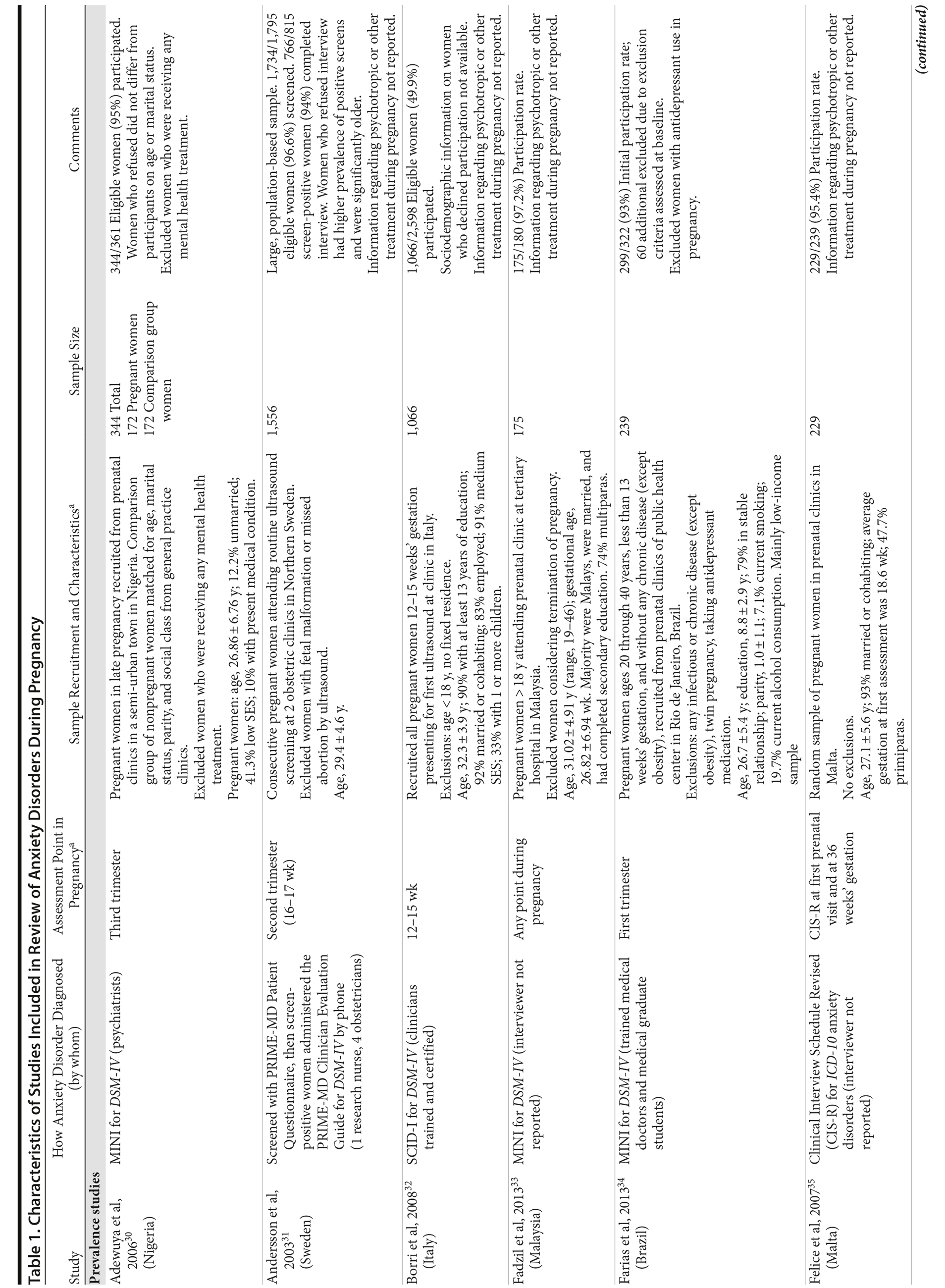
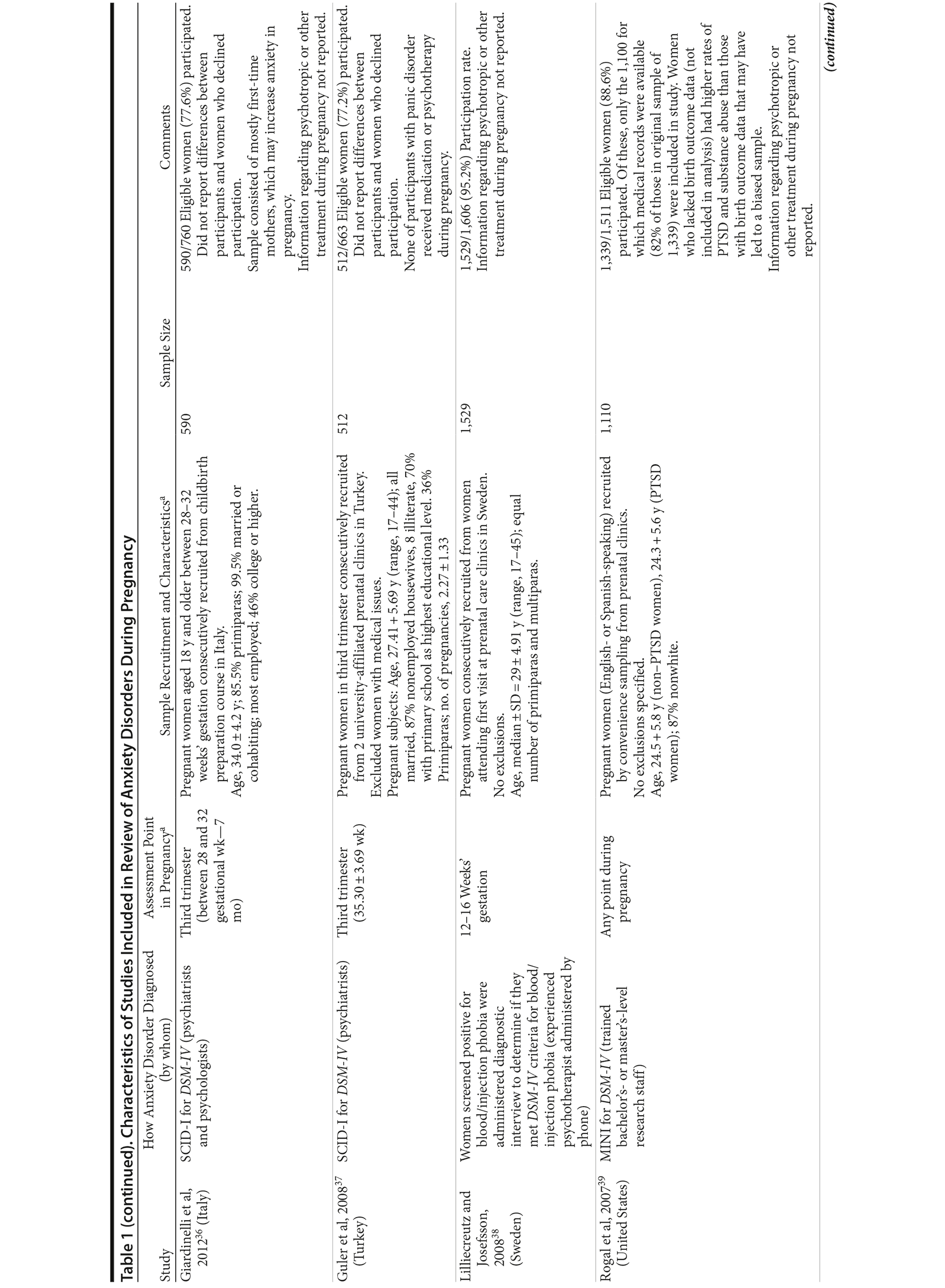



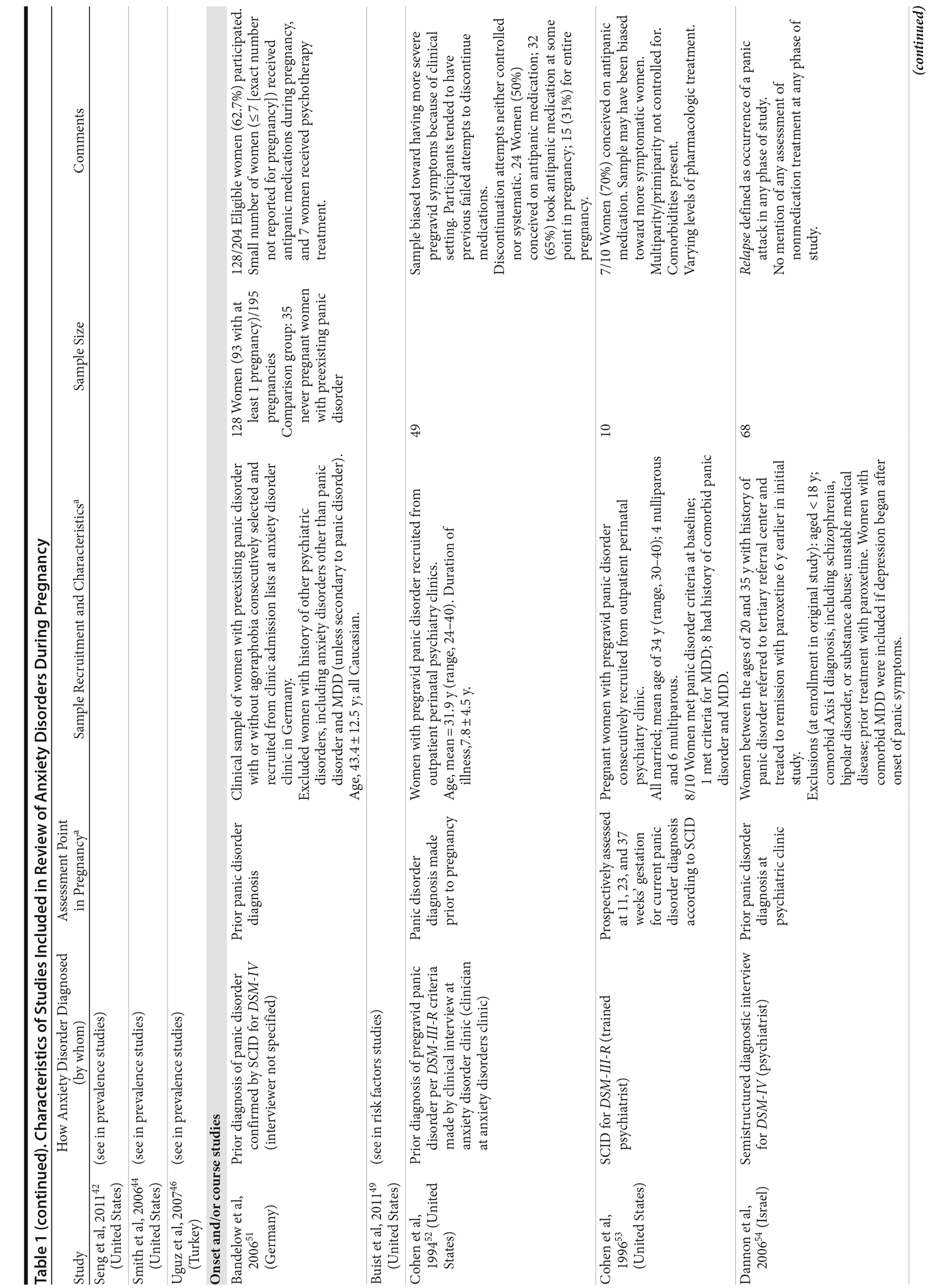
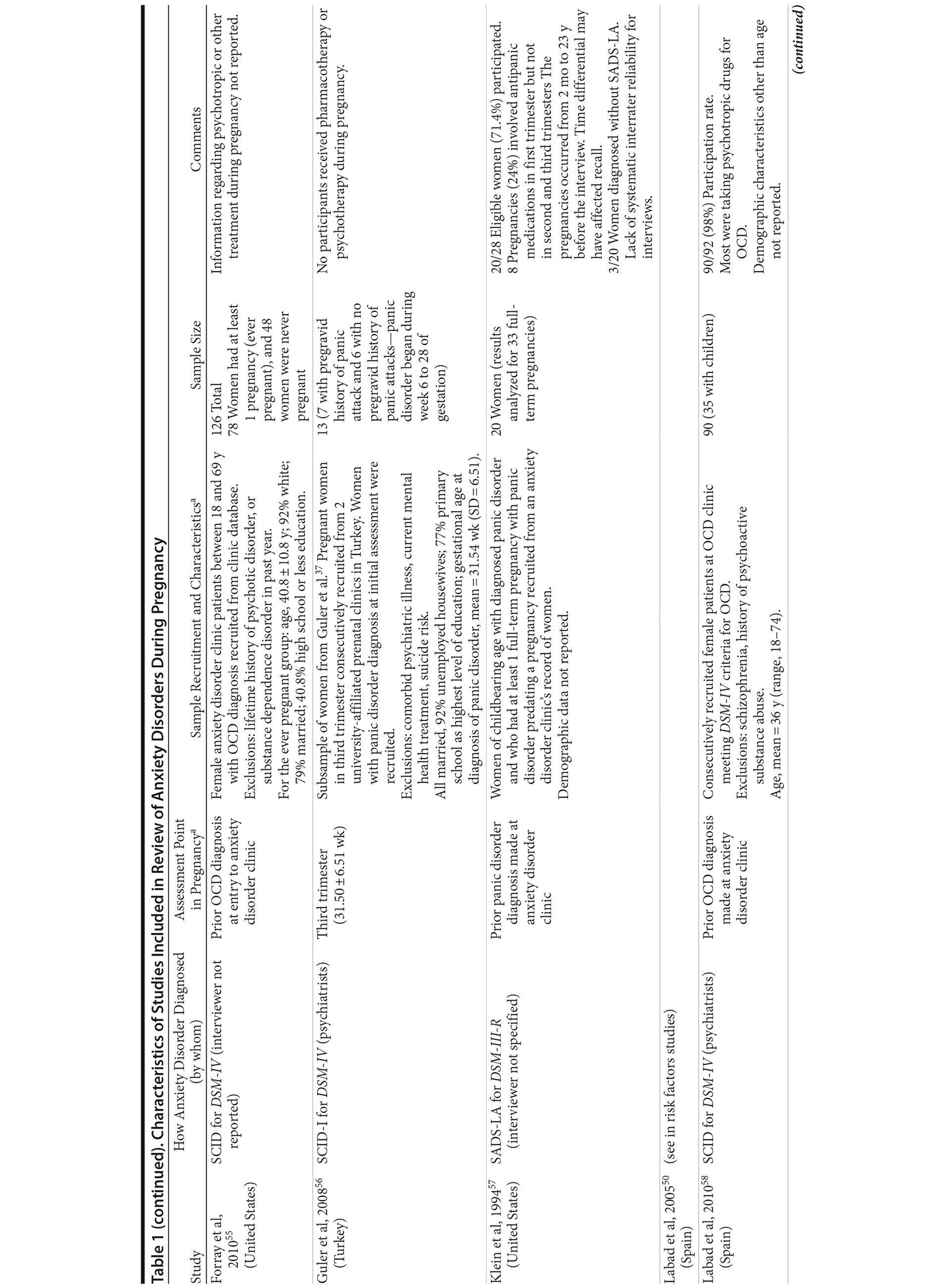

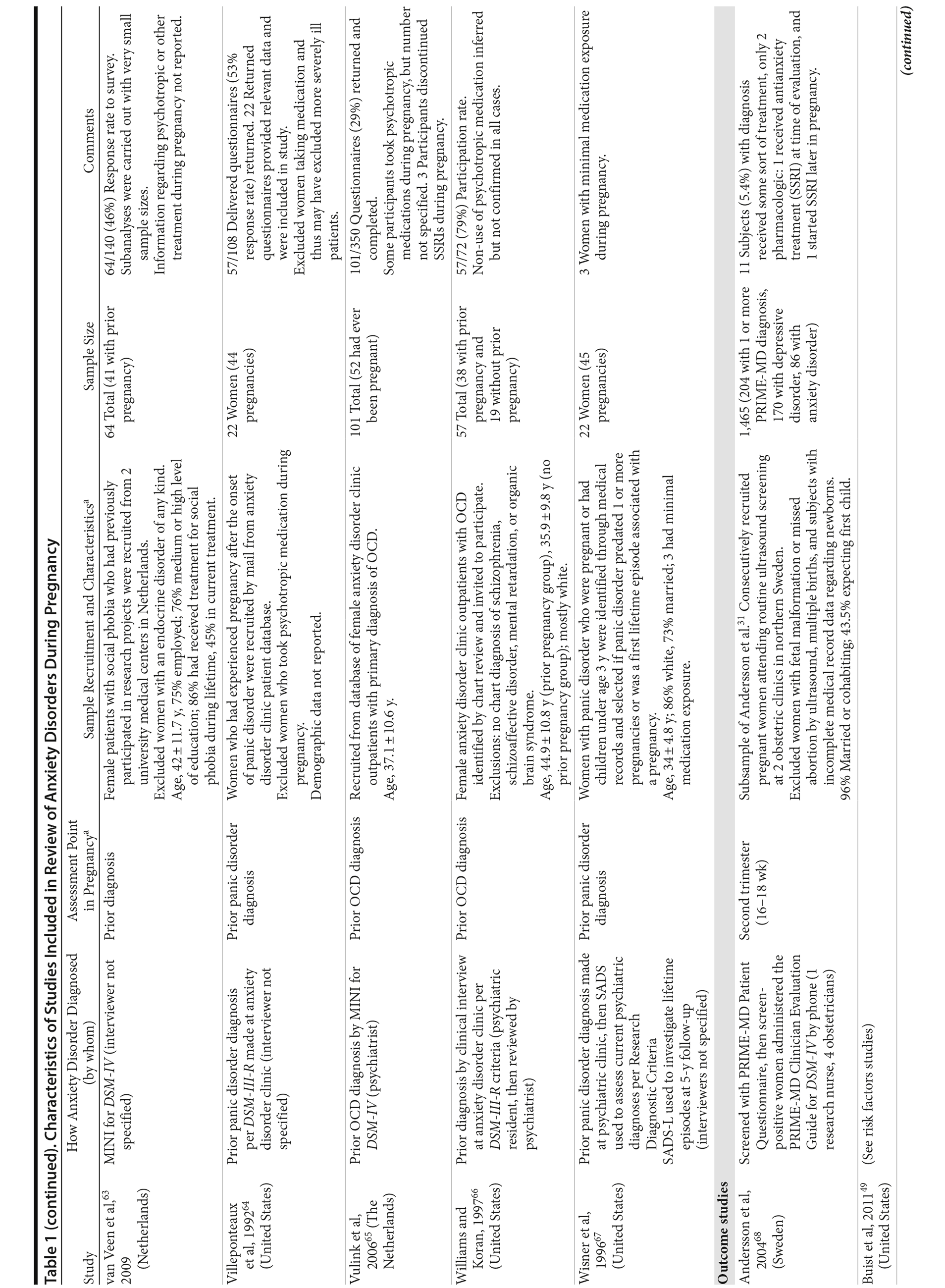
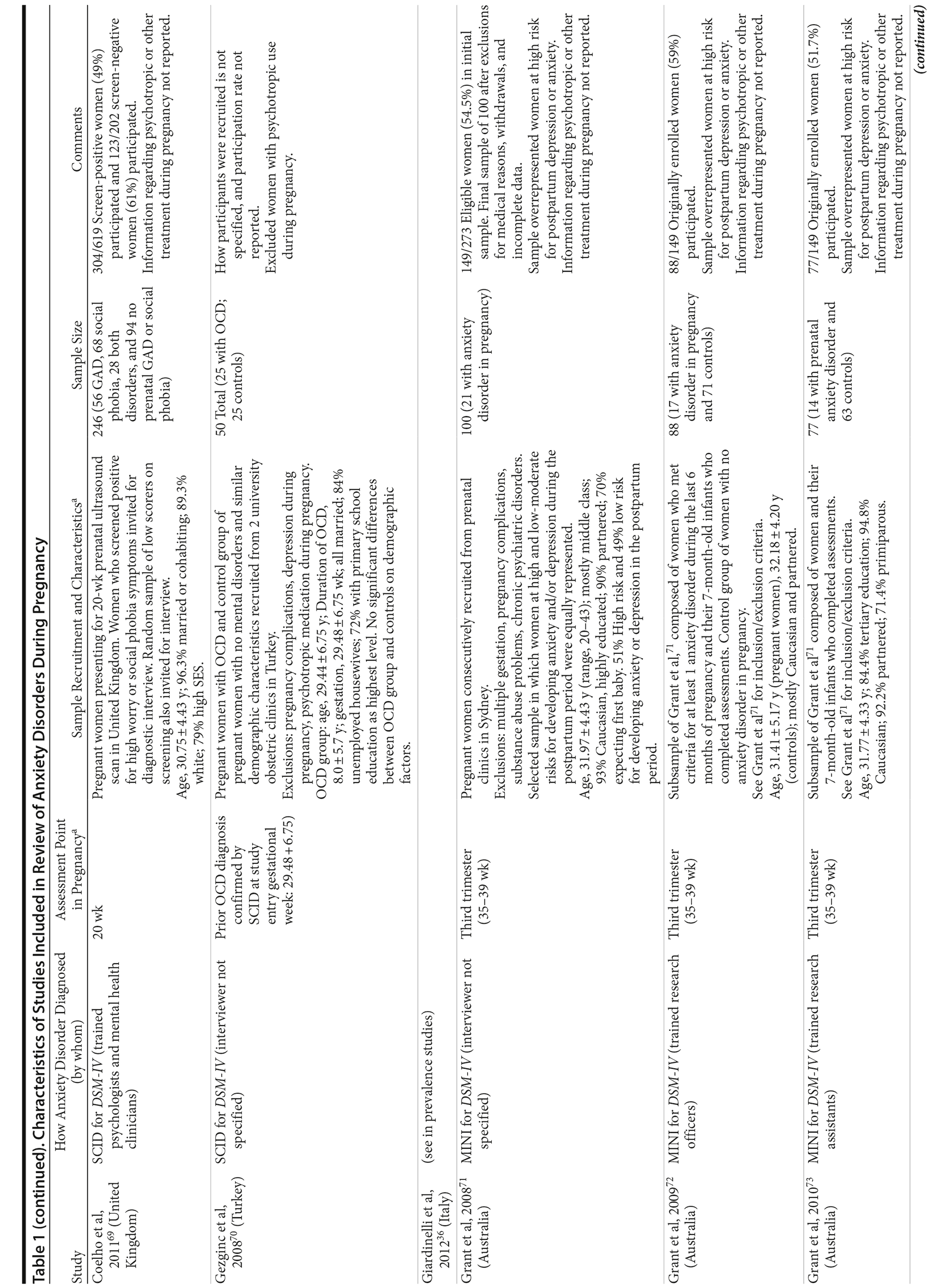
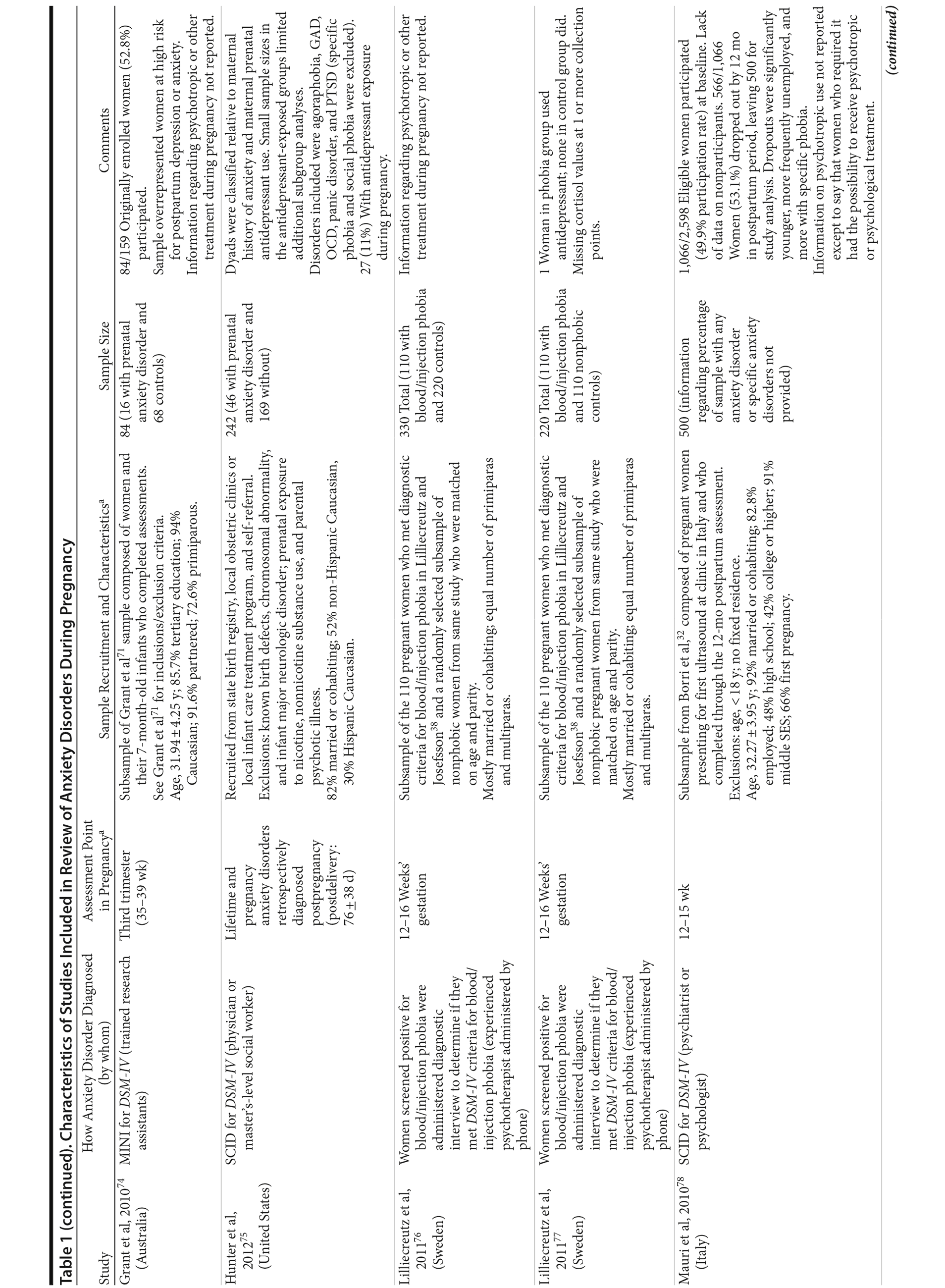
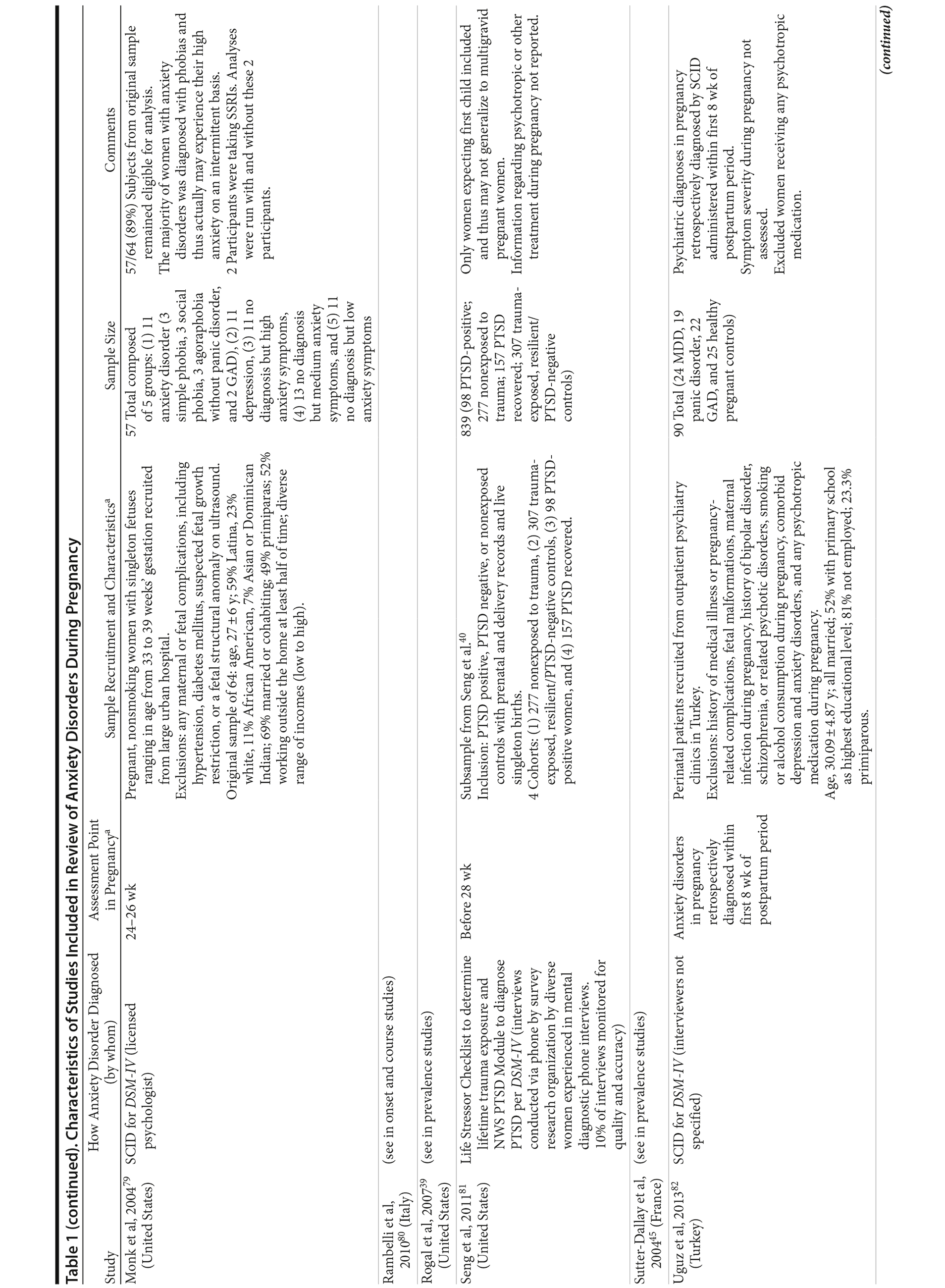

Most studies used diagnostic criteria from the DSM, 1 used ICD-10 criteria,35 and 1 used Research Diagnostic Criteria.67 Only 1 study49 specified any modifications for anxiety disorder diagnostic criteria in pregnancy. The most commonly used diagnostic interview was a version of the Structured Clinical Interview for DSM,86 which was used in 22 studies, followed by the MINI-International Neuropsychiatric Interview,87 which was used in 13 studies. Seventeen reports provided no information on the professions or qualifications of the interviewers determining diagnoses. In 24 studies, a psychiatrist, psychologist, or other mental health clinician conducted the diagnostic interviews, and, in the remaining studies, interviews were conducted by research nurses, other health care professionals, or trained lay people. Few studies provided information regarding interviewer training or the qualifications criteria by which interviewers (especially those who were not mental health professionals) had been deemed competent.
Reports provided information on the following anxiety disorders: panic disorder (25 reports), GAD (17 reports), OCD (23 reports), agoraphobia (6 reports), specific phobia (10 reports), social phobia (14 reports), PTSD (14 reports), any phobia (1 reports), and any anxiety disorder (18 reports). Twenty reports provided information on prevalence, 16 on course, 10 on comorbid disorders, 10 on risk factors, and 22 on outcomes. Only 1 study tested an intervention for an anxiety disorder in pregnancy.
Prevalence of Anxiety Disorders in Pregnancy
Twenty reports representing 18 samples examined the prevalence of 1 of more anxiety disorders during pregnancy (see Table 2). Studies were conducted in 9 different countries: 7 studies (representing 5 samples) in United States, 7 in Europe, 3 in Eurasia, 1 in Africa, 1 in Asia, and 1 in Latin America. Most studies used samples recruited from hospital- or community-based prenatal clinics. One study36 recruited participants from a prenatal class, and another sample29 was derived from a large US epidemiologic survey. Diagnostic interviews were conducted during the first trimester of pregnancy (1 study), second trimester (3 studies), and third trimester (6 studies) and at any point during pregnancy (10 studies). Studies did not provide information enabling determination of whether prevalence varies in relation to stage of pregnancy, neither did they discriminate between anxiety disorders existing prior to pregnancy or with pregnancy onset. With the exception of 1 study35 in which diagnostic interviews were administered at 2 separate time points in pregnancy, each study examined prevalence of anxiety disorders only once during pregnancy.
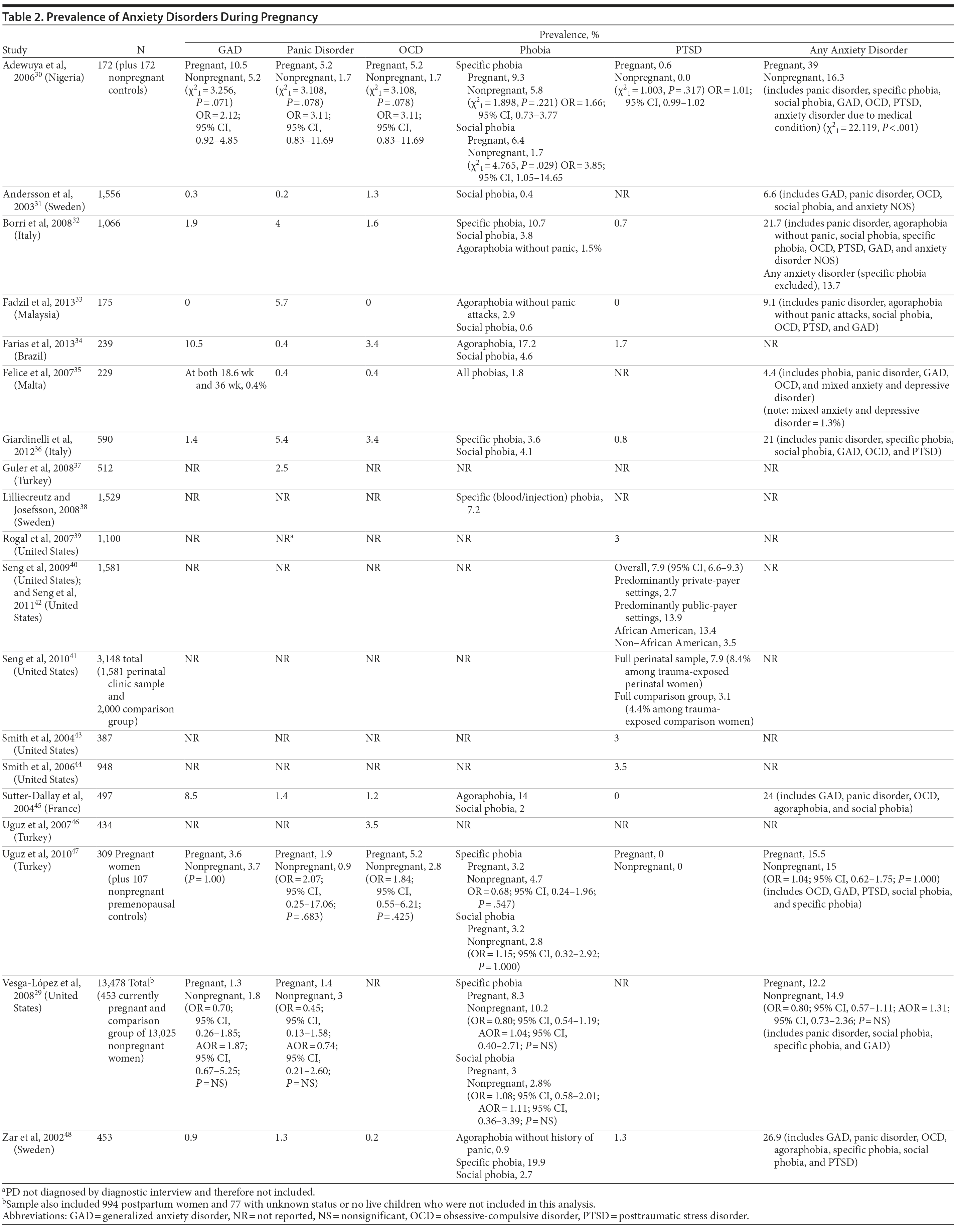
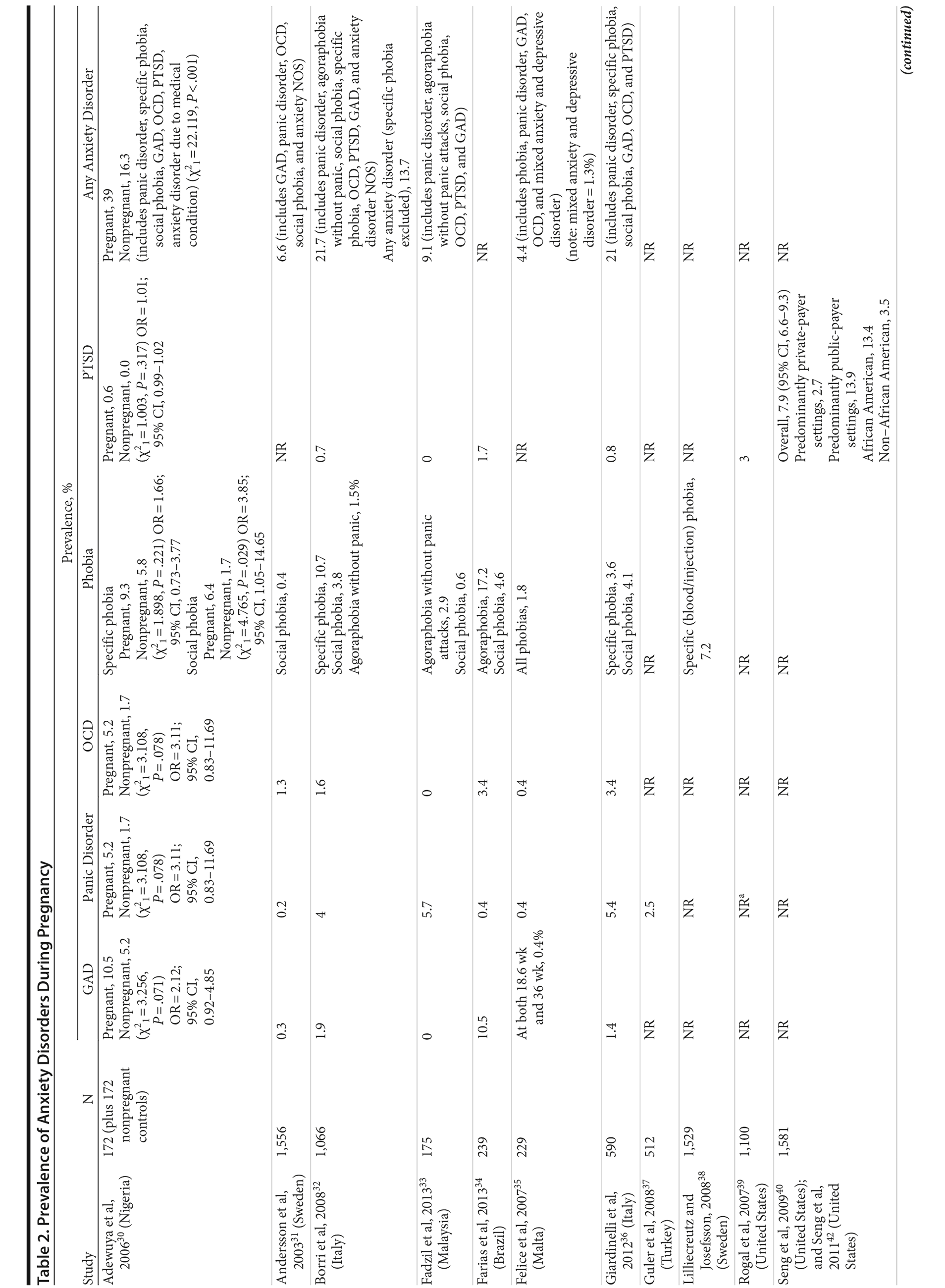

Sample sizes ranged from 172 to 14,549 pregnant women. Most studies used random or consecutive sampling, 1 used convenience sampling,39 and 3 did not report sampling method.30,33,34 As per the review inclusion criteria, all studies utilized a diagnostic interview to determine anxiety disorder diagnoses. With the exception of 1 study35 that used ICD-10 diagnostic criteria for anxiety disorders, all used DSM-IV anxiety disorder diagnostic criteria. Only 5 studies30,41,44,46,47 utilized a relevant comparison group of nonpregnant women.
One study30 excluded women who were currently receiving any mental health treatment, which may have decreased prevalence by excluding the most ill women. This study, which was carried out in Nigeria, nevertheless had the highest prevalence of any anxiety disorder found in the review. Two studies37,46 stated that no participants were taking psychotropic medications during pregnancy. None of the remaining studies reported on mental health treatment during pregnancy of the participants.
Prevalence estimates reported. Prevalence estimates varied widely, both for specific disorders and for overall prevalence of any anxiety disorder in pregnancy. Prevalence estimates for any anxiety disorder ranged from 4.4% to 39%. Prevalence of specific anxiety disorders ranged from 0%-10.5% for GAD (11 studies), 0.2%-5.7% for panic disorder (12 studies), 0%-5.2% for OCD (11 studies), 3.2%-19.9% for specific phobia (7 studies), 0.4%-6.4% for social phobia (10 studies), 0.9% for agoraphobia without history of panic to 17.2% for any agoraphobia (5 studies), and 0%-7.9% for PTSD (11 studies). In studies in which presence of any anxiety disorders was assessed, some or all anxiety disorders were included. For example, inclusion of specific phobia in determining prevalence of anxiety disorders greatly increases the prevalence, as specific phobias are the most common anxiety disorder, although arguably not the most debilitating. Forest plots were produced to give a graphical representation of the studies and to convey the extent of heterogeneity between prevalence estimates (see eTable 1 at PSYCHIATRIST.COM).
Comparisons of rates between pregnant women and controls. Only 4 studies29,30,41,47 utilized control or comparison groups to compare prevalence of anxiety disorders in pregnant versus nonpregnant women. Two studies showed no differences in prevalence between pregnant and nonpregnant women, and 2 showed significant differences. Uguz et al47 compared the prevalence of each of the specific DSM-IV anxiety disorders as well as that of any anxiety disorder among pregnant and nonpregnant and found no significant differences in rates between the 2 groups. Similarly, in a study using data from the large US epidemiologic survey,29 there were no significant differences in the prevalence of individual anxiety disorders or in presence of any anxiety disorder between pregnant women and nonpregnant women. Conversely, in a small study of pregnant women in Nigeria,30 having any anxiety disorder was significantly more common among pregnant women compared to nonpregnant women, and the rate for social phobia was significantly higher in the pregnant women compared to controls. There were nonsignificant increases in the rate of other anxiety disorders among pregnant women. Lastly, in a study of PTSD, Seng et al41 compared 1,581 pregnant prenatal clinic patients to a subsample of 2,000 women in a similar age range from the US National Women’s Study. The prevalence of PTSD in the pregnant sample was more than twice as high as that found in the comparison group.
Psychiatric Disorders Comorbid With Anxiety Disorders in Pregnancy
Ten of the included studies reported psychiatric diagnoses comorbid with anxiety disorders in pregnancy (eTable 1), revealing substantial comorbidity of major depression with anxiety disorders, as well as high rates of having more than 1 anxiety disorder among pregnant women. No information was reported on whether comorbidities with anxiety disorders during pregnancy differed from those in nonpregnant populations. No studies in our review reported specifically on comorbidities with GAD or any phobias.
Onset of Anxiety Disorders in Pregnancy
Seven studies provided information regarding onset of OCD in pregnancy46,50,55,58-60,66 and 4 regarding onset of panic disorder56,61,67,80 (eTable 2). Studies were small and data were collected retrospectively. Onset of OCD in pregnancy ranged from 0% to 15.4%. An additional study reported development of obsessive-compulsive symptoms in 39% of women during pregnancy.60 Onset of panic disorder ranged from 0% to 53.8%. These wide ranges are most likely due to differing study designs and populations.
Course of Anxiety Disorders in Pregnancy
Several studies examined the course of OCD or panic disorder in pregnancy, and 1 looked at the course of social phobia. All studies were composed of samples of women with the relevant preexisting disorder. Most included women recruited from anxiety disorder clinic populations and thus may represent women with more severe anxiety disorders. With few exceptions,53,54 these studies were limited by retrospective design. Women were asked to remember symptom severity from time periods ranging from earlier in current pregnancy to up to many years past in some studies. Consideration of potential confounders, such as psychotropic use or psychotherapeutic treatment, was absent in most of the studies. No studies were found that examined course of GAD, PTSD, or phobias other than social phobia during pregnancy.
Course of OCD in pregnancy. Six studies examined the course of OCD during pregnancy (Table 3). Four studies comprised anxiety disorder clinics patients, which may overrepresent women with more severe illness and comorbidities. Two studies included pregnant women recruited from prenatal clinics who screened positive for OCD. Sample sizes were small, ranging from 12 to 78 women. All studies used retrospective reports to characterize the course of OCD. Four were limited by lack of information regarding treatment, including psychopharmacologic treatment.



In 5 of the 6 studies, the greatest proportion of participants (44%-83%) reported no change in OCD symptoms during pregnancy. Decrease of symptoms occurred in 8%-23%, and increase of symptoms occurred in 8%-46.1%. In 1 study,55 a variable course of symptoms across pregnancies was observed for some women, with symptom increase in one pregnancy and no change or symptom decrease in another pregnancy.
Course of panic disorder in pregnancy. Nine studies examined the course of panic disorder during pregnancy (Table 3) using samples ranging from 7 to 93 women. With the exception of 2 studies,53,54 all used retrospective reports of women regarding panic disorder symptoms in prior or current pregnancies. All study samples comprised anxiety disorder clinic patients, except for 156 that comprised obstetric clinic patients. Two studies examined panic disorder in samples of women without psychopharmacologic treatment during pregnancy, 1 study did not report psychotropic exposure, and 5 included women with psychotropic exposure for some or all of the pregnancy.
The course of panic disorder varied widely among the studies, with no consistent pattern. Four reported that the greatest proportion of participants experienced symptom improvement, 1 study reported worsening in the majority of women with panic disorder, and 4 reported little change in symptoms across pregnancy. Dannon et al54 conducted a naturalistic study comparing panic disorder relapse rates among 2 groups of women with history of panic disorder who had been treated to remission with paroxetine 6 years earlier. Women with onset of panic disorder in a prior pregnancy (PD-P) and women with panic disorder onset while not pregnant (PD-NP) were compared. Relapse was defined as occurrence of a panic attack. Women with pregnancy-onset panic disorder had significantly higher risk of relapse with a subsequent pregnancy than nonpregnancy-onset women (F4,76 = 11.8, P < .001). Of women with subsequent pregnancies, 57% (n = 15/26) of the PD-P women relapsed during a subsequent pregnancy compared to 44.4% (n = 8/18) of PD-NP women who did so. The PD-NP women also had a higher rate of relapse during future pregnancies (F1 = 3.4, P < .035). For both groups of women, there was (1) an increased risk of relapse during pregnancy,(2) a history of panic disorder onset during pregnancy that constituted a higher risk of relapse during a subsequent pregnancy, and (3) more severe relapse in women who relapsed during pregnancy compared with nonpregnant relapsers. Overall, the review revealed inconsistent, unpredictable courses that varied between women and between pregnancies for multiparous women. In general, panic disorder symptoms may worsen, improve, or stay the same during pregnancy.
Course of phobia in pregnancy. One study examined the course of phobia during pregnancy. van Veen and colleagues63 retrospectively examined the course of social phobia across pregnancy in a sample of 41 women with prior pregnancies. Most women (59%) reported no change in social phobia symptoms during pregnancy. Subgroup analyses of women who reported social phobia symptoms in both pregnancy and postpartum showed that women reported statistically fewer symptoms in pregnancy compared to prior to pregnancy and in the postpartum period. In addition to retrospective recall, this study was limited by a low response rate (46%) and very small sample sizes in the subgroup analyses.
Risk Factors Associated With Anxiety Disorders in Pregnancy
Four studies30,32,33,35 reported risk factors for a diagnosis of any anxiety disorder in pregnancy. Only 3 factors (being single, low SES, and primiparity) were examined as potential risk factors in more than 1 study, with conflicting findings found for each. Additional potential risk factors were examined in only 1 study each. The lack of comparable data makes combining of results impractical. Findings are presented in eTable 3.
Risk factors for PTSD were examined in 2 studies (3 publications). Seng et al40 compared demographic, trauma history, and posttraumatic stress-related psychiatric characteristics across 5 mutually exclusive pregnant cohorts: nonexposed, trauma-exposed but PTSD-negative, partial PTSD, past PTSD, and current PTSD. The strongest risk factors (P ≤ .013 for each) were worst antecedent trauma was childhood abuse; worst trauma was a previous miscarriage or abortion that was experienced as traumatic, cumulative SES risk factors, depression diagnosis, GAD diagnosis, and previous therapy or medication. Using the same sample, Seng et al42 conducted additional analyses to compare African American women and non-African American women on risk for PTSD in pregnancy. Although PTSD in pregnancy was 4 times higher among African American women (13.4%) compared to non-African American women (3.5%), race was not a significant factor once trauma history was accounted for. The higher rates of PTSD in pregnant African American women were accounted for by greater trauma exposure, particularly child and adult abuse trauma. Having accessed treatment prior to pregnancy was a significant predictor of PTSD for non-African American women but not for African American women. In another study44 of 948 low-income pregnant women, the following factors were significant predictors of PTSD: current depression, current panic disorder, current suicidality, sexual molestation, and serious physical attack or assault. When only women who reported a past traumatic event were included in analysis (n = 278), prior or current mental health treatment, current depression, current panic disorder, current suicidality, and sexual molestation were significant predictors of PTSD in pregnancy. Posttraumatic stress disorder was less likely in women who experienced a trauma more than a year ago, compared to women who experienced a trauma within the last year.
Buist et al49 examined risk factors for GAD in a cohort of 2,793 pregnant women, comparing women with no GAD diagnosis to the following 3 groups: (1) GAD in 6 months prior to pregnancy only (group A), (2) GAD in pregnancy only (group B), and (3) GAD in 6 months prior to and during pregnancy (group C). Previous history of GAD was the strongest predictor of GAD in pregnancy. Women with 4 or more prior GAD episodes were significantly more likely to experience GAD in pregnancy (groups B and C). Both groups B and C had significantly lower social support compared to the no-GAD group. Group B had significantly more black women compared to the no-GAD group. Group C women were significantly more likely to have experienced childhood abuse and were significantly less educated compared to no-GAD women. Limitations of the study include a selected sample of women at high risk for depression, PTSD, and antidepressant use, with possible confounding effects of medication on GAD.
Uguz et al46 looked at factors related to OCD in pregnant women during the third trimester of pregnancy. There were no significant differences between pregnant women with (n = 15) and without (n = 419) OCD with regard to age, educational level, employment status, number of gestations and live births, gestational weeks, duration of marriage, history of abortion, and the existence of gestational complications. There was, however a statistically significant difference between pregnant women with and without OCD with regard to family history of OCD. A family history of OCD was reported by 33.3% of pregnant women with OCD versus 2.4% of pregnant women without OCD (P < .0001). Another study50 reported that neither past nor present history of major depressive episodes was associated with onset or worsening of OCD in pregnancy.
Outcomes Associated With Anxiety Disorders in Pregnancy
Nineteen studies (representing 16 samples) reported on outcomes associated with anxiety disorders in pregnancy. Findings are reported in Table 4.
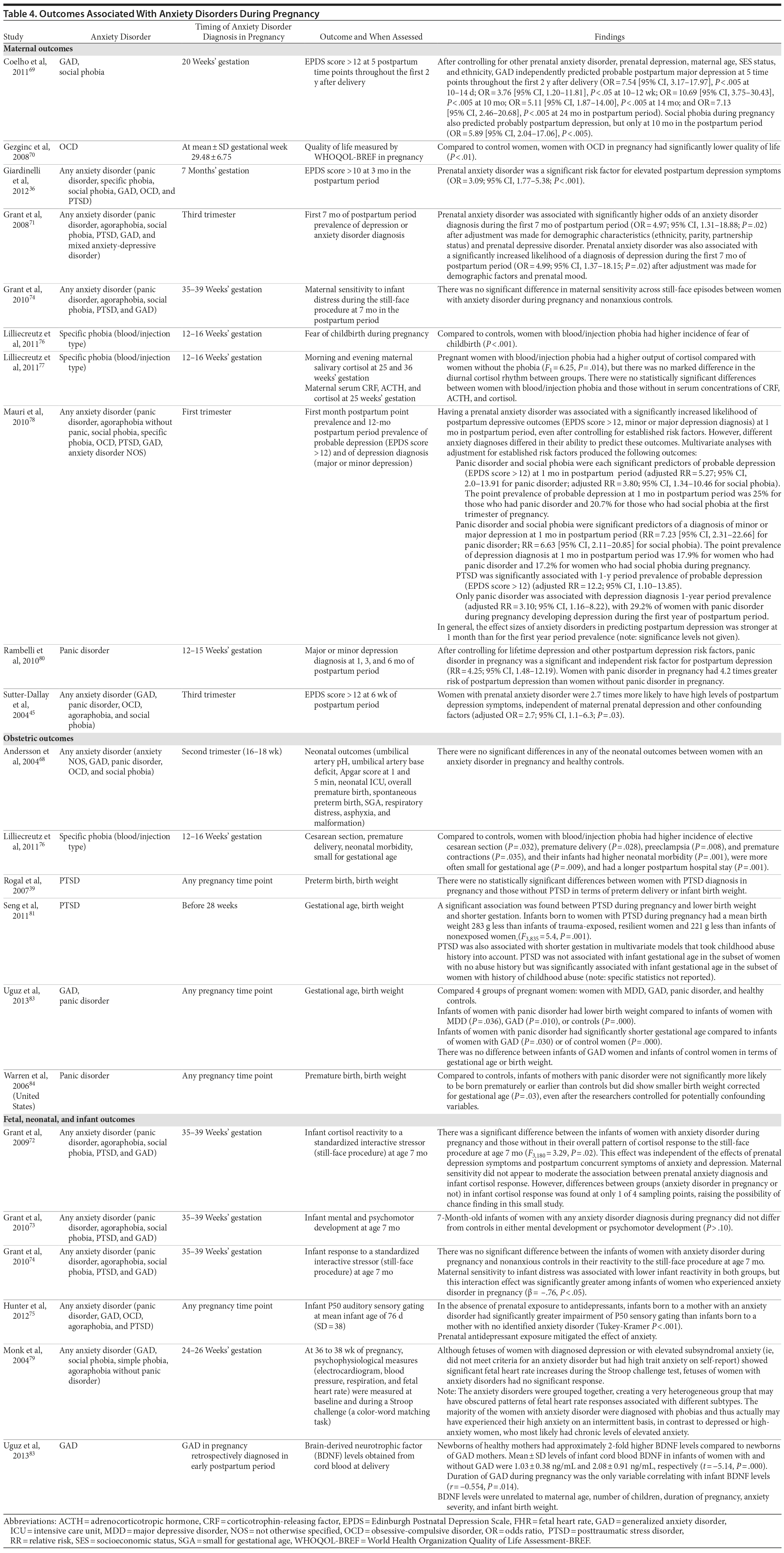
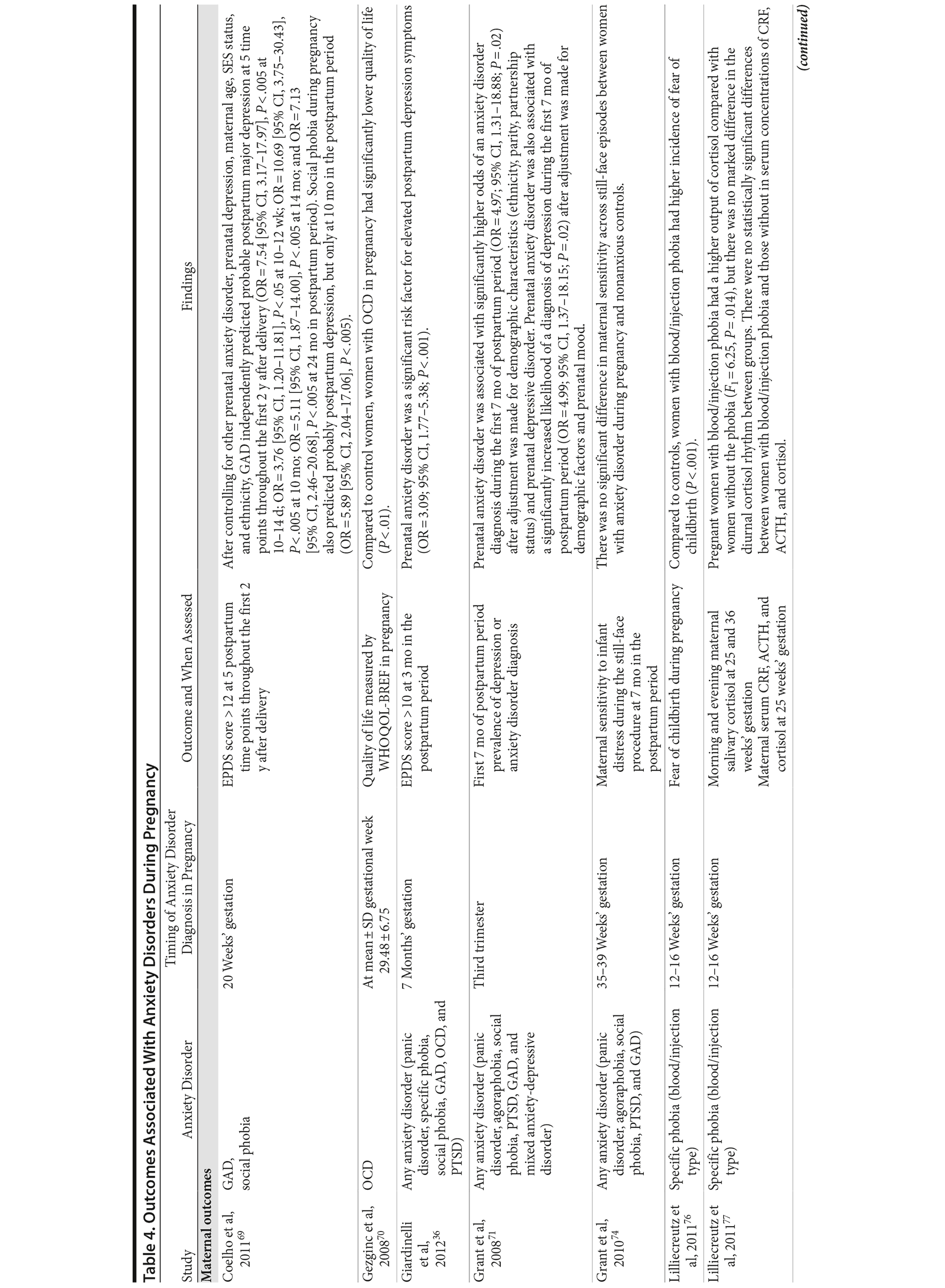
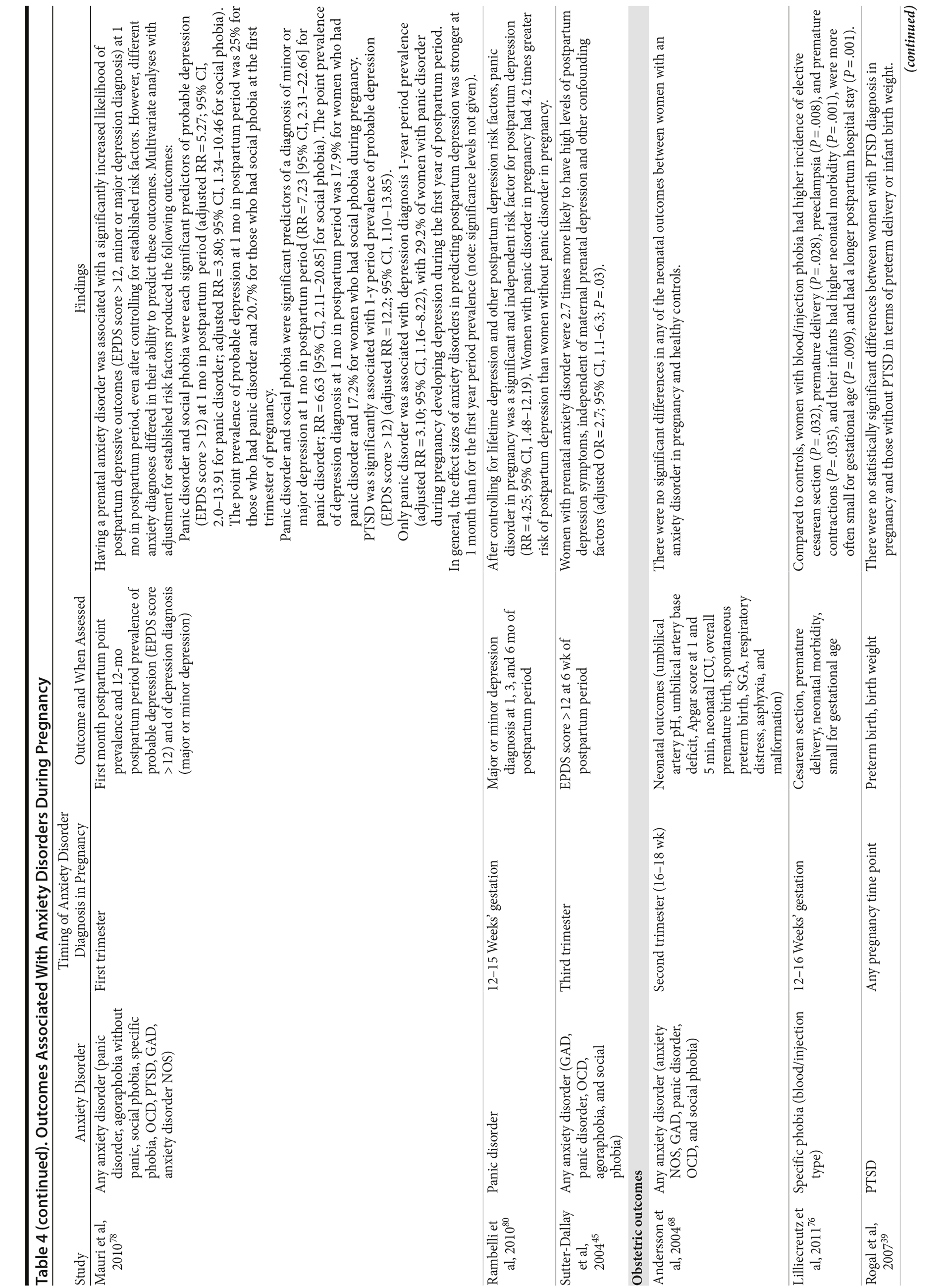
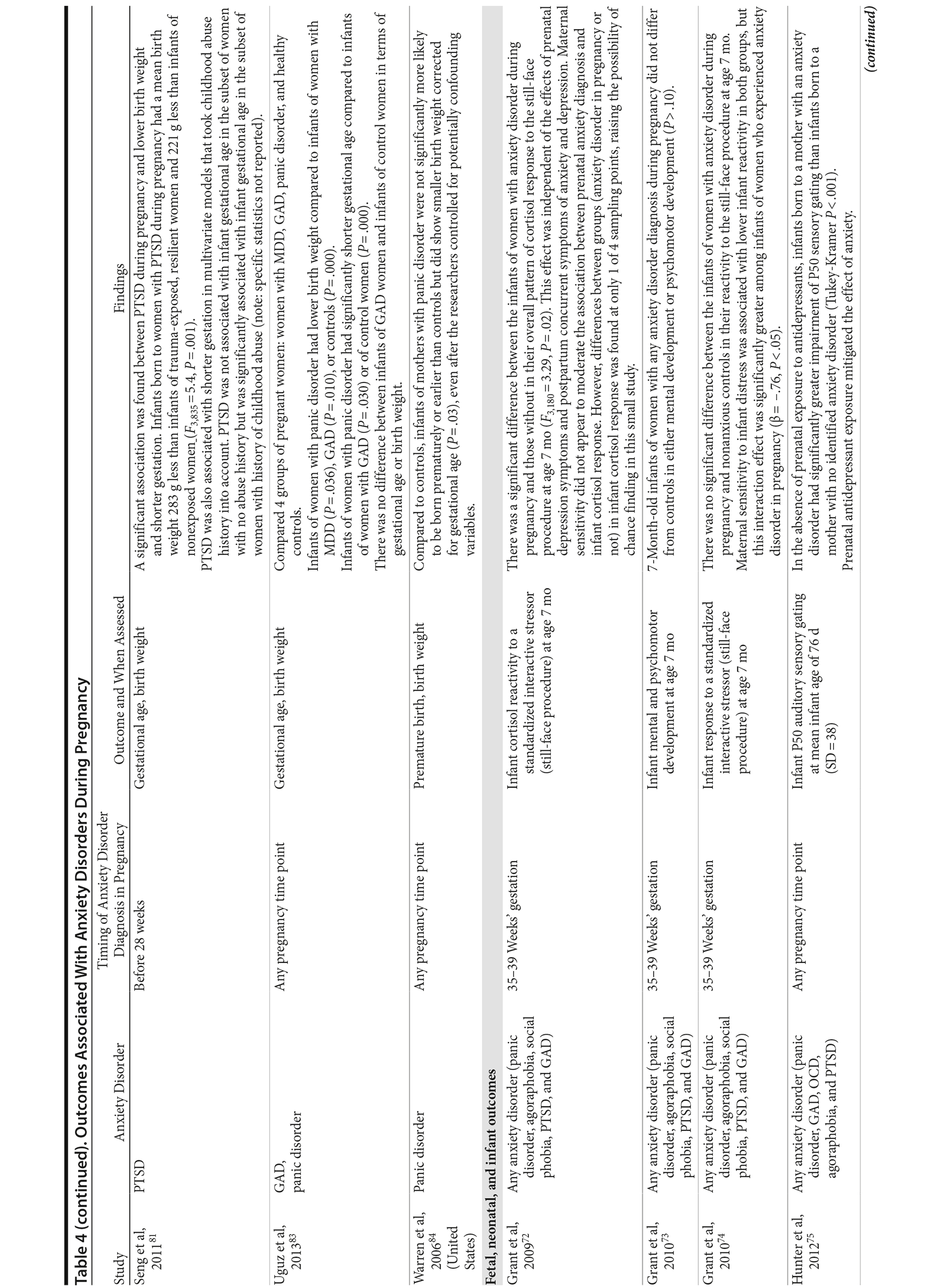
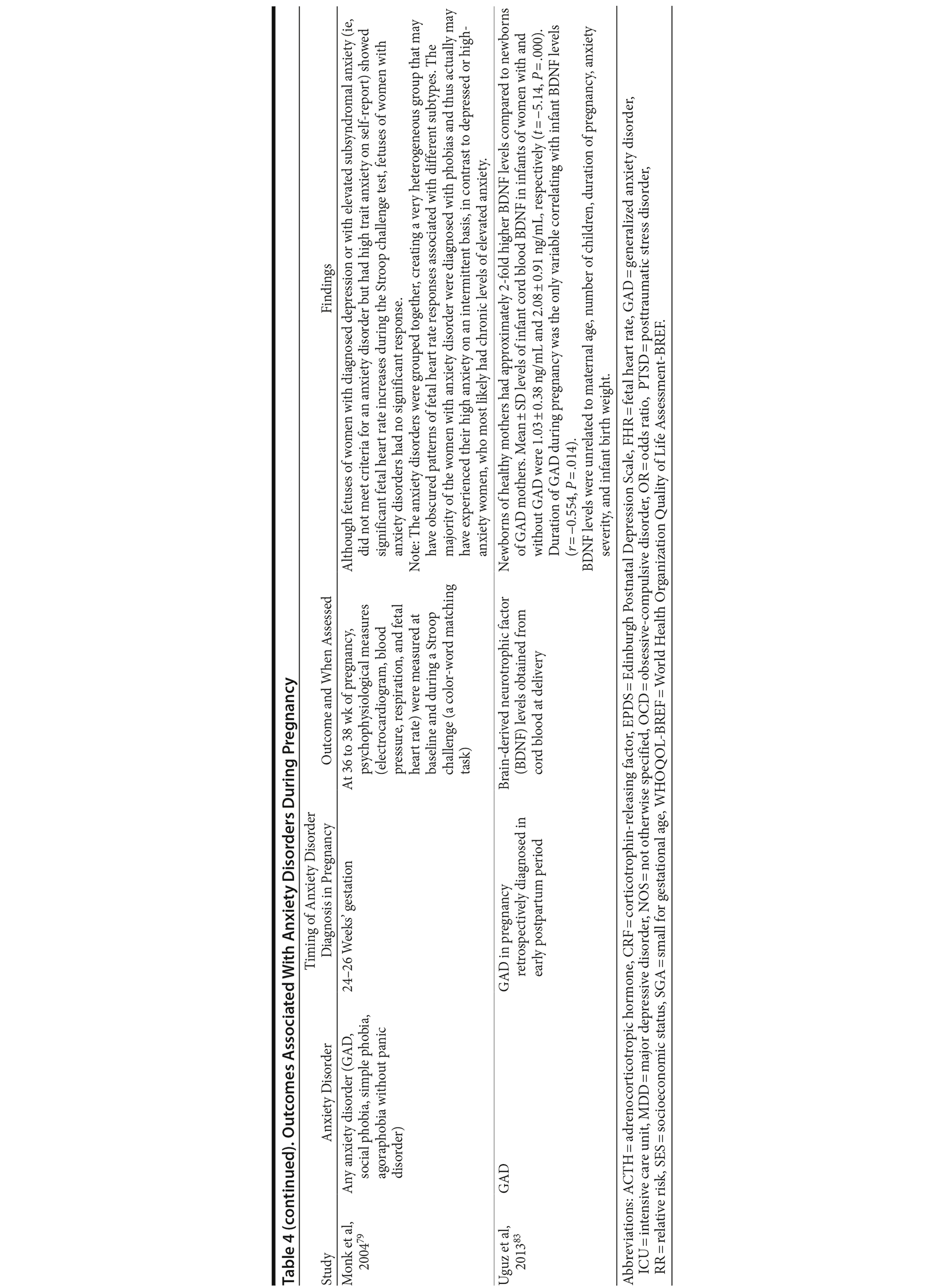
Maternal outcomes. Ten studies (2 that utilized the same sample76,77) examined maternal outcomes associated with anxiety disorders during pregnancy. Six of the studies investigated prenatal anxiety disorders as a potential risk factor for postpartum depression (defined variably as either high symptom levels or diagnoses). Each reported a statistically significant association between anxiety disorders in pregnancy and subsequent postpartum depression. Findings from 1 of the studies78 furthermore suggest that type of anxiety disorder may affect postpartum depression risk differentially: whereas a prenatal diagnosis of agoraphobia, specific phobia, OCD, PTSD, or GAD was not associated with postpartum depression symptoms or diagnoses, panic disorder and social phobia were significant predictors of both elevated Edinburgh Postnatal Depression Scale (EPDS) scores and DSM-IV diagnoses of minor or major depression at 1 month postpartum. Panic disorder (but not social phobia) was a significant risk factor for depression diagnosis during the first year postpartum.
Coelho and colleagues69 looked specifically at GAD and social phobia as potential predictors of postpartum depression (EPDS score > 12) and found that, after controlling for prenatal depression diagnosis, other prenatal anxiety disorders, maternal age, SES status, and ethnicity, GAD was an independent predictor of postpartum depression at each of 5 time points assessed over the first 2 years after delivery. Social phobia during pregnancy also predicted postpartum probable depression, but only at 10 months postpartum.
Only 1 study71 examined prenatal anxiety disorder diagnosis as a risk factor for postpartum anxiety disorders. In addition to examining major depression diagnosis as an outcome, Grant et al71 also examined the association between prenatal anxiety disorders and postpartum anxiety disorder diagnosis. After adjustments were made for demographic characteristics and prenatal depressive disorder, having an anxiety disorder during pregnancy was associated with a nearly 5-fold increased likelihood of depression and an equally high increased likelihood of experiencing an anxiety disorder in the first 7 months postpartum.
Other maternal outcomes examined included quality of life, fear of childbirth, and cortisol levels in pregnancy. Gezgniç et al70 reported a significantly lower quality of life in pregnant women with OCD compared to matched pregnant controls without OCD. In 2 studies comparing the same sample of women with blood/injection phobia in pregnancy to control women, both higher incidence of fear of childbirth76 and higher salivary cortisol level during pregnancy77 were found in the phobic women.
Obstetric outcomes. Six studies examined the association of obstetric outcomes with maternal anxiety disorders during pregnancy. Birth weight (or gestational size) and/or preterm delivery (or gestational age) were examined outcomes in all 6. There were mixed findings regarding whether anxiety disorders affect birth weight. Three reported no significant differences in regard to infant birth weight when comparing infants of control women without the condition to infants of women with any anxiety disorder,68 PTSD,39 or GAD.82 Other studies, however, did find significant differences in infant birth weight or size for gestational age. Compared to women without the condition, women with blood/injection phobia in pregnancy were significantly more likely to have infants who were small for gestational age.76 Birth weight was significantly lower in infants of women with PSTD in pregnancy compared to women without the diagnosis81 and in infants of mothers with panic disorder in pregnancy than in infants of healthy control women.84 In a study82 that compared 4 groups of pregnant women (women with major depression, GAD, or panic disorder and healthy controls), infants of women with panic disorder had the lowest birth weights, significantly lower than infants of women with depression or GAD or healthy controls.
There were similarly mixed findings regarding anxiety disorders in pregnancy and gestational age at delivery or preterm birth. Three studies reported shorter gestational age or preterm birth among infants of women with panic disorder,82 blood/injection phobia,76 or women with PTSD.81 Other studies reviewed reported no difference between infants of control women and infants of women with panic disorder,84 PTSD,39 or any AD.68
Additional obstetric outcomes were examined by Lilliecreutz and colleagues,76 who reported that, compared to controls, women with blood/injection phobia had higher rates of elective cesarean section, premature delivery, preeclampsia, and premature contractions. Their infants had higher neonatal morbidity, were more often small for gestational age, and had a longer postpartum hospital stay. Andersson and colleagues68 examined several obstetric and neonatal outcomes and found no significant differences in outcomes between women with anxiety disorder in pregnancy and healthy controls.
Fetal, neonatal, and infant outcomes. Six studies (3 utilizing the same sample72-74) examined fetal/infant outcomes associated with maternal anxiety disorders during pregnancy. One study83 found significantly higher brain-derived neurotropic factor (BDNF) in the cord blood of newborns of mothers with no psychiatric disorder compared to mothers with GAD in pregnancy, suggesting a possible negative influence of GAD on fetal neurodevelopment through lower BDNF levels. In a study examining fetal heart rate in response to maternal stress,79 the Stroop Challenge test was administered at 36 to 38 weeks’ gestation to 57 women, 11 with an anxiety disorder, 11 with a depression diagnosis, and 35 without psychiatric diagnosis. Participants were subdivided into 3 groups (high anxiety, middle anxiety, and low anxiety) based on the State Trait Anxiety Inventory. Fetuses of women with depression or with high anxiety, but who did not meet criteria for an anxiety disorder, showed significant fetal heart rate increases during the Stroop test; however, fetuses of women with anxiety disorders had no significant response. The study authors suggested that the lack of response among fetuses of mothers with anxiety disorder may have been due to (1) heterogeneity of disorders in the anxiety disorder group; (2) uneven distribution of birth weight among groups, with trend for heavier weight in infants in the anxiety disorder group, which may affect fetal heart rate reactivity; and (3) the fact that the majority of mothers with anxiety disorder were diagnosed with phobias and may actually experience their high anxiety on an intermittent basis, whereas depressed women and those with high-anxiety symptoms very likely have chronic levels of elevated anxiety.
In a prospective, longitudinal study, Grant and colleagues72 examined outcomes in a sample of infants whose mothers (n = 17) met criteria for at least 1 anxiety disorder during the last 6 months of pregnancy and 71 control women with no diagnosis during pregnancy. At age 7 months, infants and mothers attended a 1-hour laboratory session in which they took part in the still-face procedure, a short interactive stress paradigm used in many research studies to induce and examine infant response to a mildly stressful event. Infant salivary cortisol level was measured upon arrival and at 15, 25, and 40 minutes following the still-face procedure, and maternal sensitivity to infant distress and nondistress was observed. There was a significant difference between infants of prenatally anxious mothers and infants of women with no anxiety disorder in their overall pattern of stress-induced cortisol response, independent of maternal depressive symptoms and concurrent (postpartum) symptoms of anxiety and depression. Although maternal sensitivity was also independently associated with infant cortisol response, it did not moderate the association between prenatal anxiety disorder and infant cortisol response. In 2 related studies using the same sample,73,74 maternal prenatal anxiety disorder did not predict infant response/reactivity to the still-face procedure. Only the interaction between prenatal anxiety disorder and maternal sensitivity to the infant significantly predicted infant reactivity. In addition to the laboratory visit, the same mother-infant dyads received a home visit at which assessments of the 7-month-old infants’ mental and psychomotor development were conducted using the Bayley Scales of Infant Development.88 No significant differences were found between infants of mothers with anxiety disorders during pregnancy and infants of control mothers on either mental or psychomotor development.
A study by Hunter and colleagues75 examined P50 auditory sensory gating in infants of mothers with or without an anxiety disorder diagnosis in pregnancy (N = 242), some with concurrent antidepressant exposure. P50 auditory sensory gating has been reported to be impaired in a number of psychiatric disorders characterized by attentional dysfunction75 and is regarded as a putative marker for early attentional processes in infants. In this study, infant P50 auditory sensory gating was recorded during active sleep at a mean age of 76 days (SD = 38). Infants whose mothers had any anxiety disorder diagnosis during pregnancy but no prenatal antidepressant exposure had diminished P50 sensory gating in infancy; however, prenatal antidepressant exposure mitigated this effect. Infants born to a mother with an anxiety disorder untreated by an antidepressant had more impaired P50 sensory gating than infants born to a mother with no identified anxiety disorder in pregnancy, a finding that suggests prenatal treatment implications of both antidepressants and interventions to increase maternal sensitivity.
Interventions for Treatment of Anxiety Disorders in Pregnancy
No randomized controlled trials of treatment for anxiety disorders in pregnancy were identified. Only 1 treatment trial85 was found: an open trial of group cognitive-behavioral therapy (CBT) for pregnant women with blood/injection phobia. Thirty women participated in a 2-session CBT group therapy led by a CBT therapist and a midwife. The 2 sessions, held 4 weeks apart, included education on and exposure to different functions of lancets, syringes, injection needles, and intravenous catheters and education on symptoms of phobic reactions and how to manage physical symptoms and associated cognitions. As homework, participants were given needles, lancets, and syringes to take home and look at and touch. At session 2, participants were exposed to a hierarchy of anxiety-provoking situations 1 or more times: pricking a finger, subcutaneous injection in the arm, vein puncture, and insertion of an intravenous catheter. Both CBT sessions included a 5-minute relaxation exercise. The main outcomes of degree of phobia were self-rated using the Injection Phobia Scale-Anxiety (IPSA) and the Injection Phobia Scale-Avoidance (IPSAV) before and after each group therapy session and at 3 months after delivery. Outcomes of women who received the treatment were compared against those of 2 control groups: pregnant women with untreated blood/injection phobia (n = 46) and healthy pregnant women (n = 70). Treatment group scores were significantly reduced on both the IPSA and IPSAV over the whole study period (P < .001 for each scale) and when scores before and after each of the 2 treatment sessions were compared (P < .001 for each session). Compared to the control groups, the CBT group had significantly higher scores of phobic symptoms compared to both untreated and healthy women before the first treatment session (P < .001). At the postpartum follow-up, the CBT group scored significantly lower than the untreated women, but higher than the healthy controls (P < .001). Overall, the treatment reduced pregnant women’s level of phobic symptoms significantly, and improvements were maintained at 3-month postpartum follow-up.
DISCUSSION
Main Findings
Our review highlights several important findings. We found that the prevalence of anxiety disorders is high among pregnant women. However, there is considerable variability in prevalence estimates for specific disorders and for any anxiety disorder among the studies, and evidence to date is inconclusive as to whether anxiety disorder prevalence among pregnant women differs from that in nonpregnant populations. In addition, at present it is not possible to discern whether there are differences in rates of anxiety disorders at various stages of pregnancy.
A small number of studies provided information regarding onset and course of anxiety disorders in pregnancy, with OCD and panic disorder best studied. There was a wide range in the proportion of women experiencing pregnancy onset of OCD or panic disorder. Although most women with preexisting OCD reported no change in OCD symptoms during pregnancy, there was considerable variation. The course of panic disorder varied widely among the studies, with no consistent pattern detected. For both OCD and panic disorder, symptoms may worsen, improve, or stay the same during pregnancy, indicating the need for a watchful and individualized approach to management. Limitations of these studies include small sample sizes, retrospective design and inherent recall bias, and little control for potential confounders, including pharmacologic and psychotherapeutic treatment. Missing from the literature was any exploration of whether women with psychiatric illness who become pregnant and who may discontinue their psychiatric medications for fear of prenatal exposure of offspring to these agents have an increased risk of relapse during pregnancy. This represents an important area for future study.
Our review of risk factors for anxiety disorders in pregnancy revealed limited findings. Only 4 studies examined risk factors for any anxiety disorder, and only 3 potential factors (single marital status, low SES, and primiparity) were examined in more than 1 study-all with conflicting results. This lack of evidence indicates a clear need for further research to identify factors that increase risk for pregnant women so that targeted monitoring and preventive interventions can be implemented.
In terms of maternal outcomes associated with prenatal anxiety disorder, 6 studies reported statistically significant associations between prenatal anxiety disorders and postpartum depression, although there were mixed findings regarding specific anxiety disorders, indicating a need for further research to determine postpartum depression risk in regard to different specific anxiety disorders. Our finding that prenatal anxiety disorders increase risk for development of postpartum depression is supported by previous research that has shown that anxiety disorders often precede development of depression.89-91 A recent study by Prenoveau et al92 reported that postpartum GAD similarly raises risk for the development of postpartum major depressive disorder (MDD). These findings highlight the importance of identifying pregnant women with anxiety disorders and offering effective treatments to both treat maternal anxiety disorders and prevent postpartum MDD. Having a prenatal anxiety disorder was also found to be a risk factor for postpartum anxiety disorders in 1 study,71 and other single studies reported lower quality of life in pregnant women with OCD70 and greater fear of childbirth and higher salivary cortisol in pregnant women with blood/injection phobia.76,77
Six studies39,68,76,81,83,84 examined effects of maternal prenatal anxiety disorders on obstetric/neonatal outcomes, with mixed findings regarding effects on infant birth weight/size or gestational age at delivery, indicating a clear need for more research on this important topic. A growing body of research has demonstrated that elevated maternal anxiety symptom levels in pregnancy are associated with adverse infant outcomes.13b,14,16,19,93-95 Therefore, it is surprising that so few studies were found that examined the effects of diagnosed anxiety disorders on the fetus or infant. One79 examined an effect of maternal anxiety disorder on the fetus, reporting that, whereas fetuses of mothers with prenatal depression or with high anxiety (but without an anxiety disorder) showed a significant heart rate increase, fetuses of mothers with anxiety disorder in pregnancy showed no significant response. Two studies examined 7-month-old infants’ responses to a mild stressor. Infants of prenatally anxious mothers had significantly higher cortisol levels than infants of mothers without an anxiety disorder in pregnancy72 but showed no significantly different behavioral response/reactivity to the stressor.74 Another study75 showed that infants of mothers with an anxiety disorder in pregnancy (and no antidepressant exposure) had decreased P50 sensory gating—a possible marker for early attentional processes in infants. This finding was mitigated by antidepressant treatment, demonstrating the importance of studying treated versus untreated illness.
Although it was beyond the scope of this review to fully investigate comorbidity of anxiety disorders with depression and other disorders, rates of comorbid psychiatric disorders were high in the 10 studies in our review in which comorbidity was reported. This finding is consistent with previous research showing that anxiety disorders and depression are highly comorbid in general populations1,89,96,97 as well as in postpartum populations.98-100 The high comorbidity of depression, multiple anxiety disorders, or both with anxiety disorders in pregnancy is of great clinical relevance, as such comorbidity increases chronicity, functional impairment, and suicidality and is associated with a less favorable prognosis than that with a single diagnosis.99,101-104
The review reveals a paucity of research regarding treatment for anxiety disorders in pregnancy. No randomized controlled trials were identified. The only study of anxiety disorder treatment in pregnancy was an open trial of a short intervention for needle/injection phobia. While it may be reasonable to assume that anxiety disorder treatments that are effective in nonpregnant populations might be effective for pregnant women as well, there is a current lack of evidence. There is a need for studies of treatments specifically geared toward the needs of pregnant women.
There are several important limitations to the available data. First, there is significant heterogeneity among studies, including substantial diversity of populations studied, risk factors examined, outcomes analyzed, and confounders controlled for in statistical analyses. In addition, the methodological quality of the studies differed considerably. Although 57 studies were included, these represented the available literature addressing several research questions regarding multiple specific anxiety disorders as well as any anxiety disorder during pregnancy. Thus, the available research on anxiety disorders in pregnancy is actually quite limited, and there is a need for much further study to satisfactorily answer the research questions posed in this review. At present, there is a limited evidence base to guide current practice and decision making.
Strengths and Limitations
This review has a number of strengths. We conducted a systematic search using inclusive search strategies. We included studies using clearly defined criteria to minimize selection bias. Only studies in which anxiety disorders were diagnosed by using a clinical interview were included, thus ensuring an important indicator of quality. We acknowledge several limitations of our review as well. It included studies published only in English. We did not attempt to include gray literature but considered only published studies. In order to enhance generalizability, we excluded specific subpopulations for whom vulnerability to anxiety disorders during pregnancy may be greater. We excluded samples comprising specific subpopulations of pregnant women, such as adolescents younger than 17 years, disaster survivors, and women with abuse histories, substance abuse problems, or specific medical or gestational problems (eg, hyperemesis, previous still birth). In addition, most studies excluded women who could not read and understand the dominant language of country in which the study was conducted, thereby limiting inclusion of immigrant and refugee women for whom anxiety may be increased. Anxiety disorders in these specific populations represent areas for further study and review.
Recommendations and Implications
Although the evidence provided from this review is limited, it does identify several areas for additional research and may provide clinicians with some suggestions to guide management. Identification and treatment of anxiety disorders in pregnancy are especially important due to the potential impact of untreated anxiety disorders during pregnancy on maternal, obstetric, and fetal/child outcomes. As recommended screening for perinatal depression becomes integrated into obstetric and other practice settings,105-107 screening for anxiety disorders should also be considered. Currently, there are no screening tools specific to anxiety and pregnancy, and it is unclear whether screening efforts to detect perinatal depression are adequate for the detection of prenatal anxiety disorders. As the course of anxiety disorders varies substantially among women, individualized risks and benefits of treatment interventions must be considered. At this time, treatment research is needed to determine the most effective treatments for anxiety disorders during pregnancy. Psychotherapies that are adapted specifically to the context of pregnancy would be attractive first-line treatments. However, some women with severe anxiety often require pharmacologic treatment. In the case of medication selection, it is rational to select medications with the most complete reproductive safety profiles and to have the patient engage in concurrent psychotherapy.
CONCLUSIONS
Although research on perinatal anxiety disorders lags greatly behind that of perinatal depression, studies of anxiety disorders in pregnancy have increased, with the majority of studies included in this review (46 studies) published in the past decade, compared to only 11 in the prior decades. This is good news. However, the findings of this review reveal that our current knowledge is limited and there is much we don’ t yet understand about anxiety disorders in pregnancy. Additional research is required to develop a solid evidence base on which to guide clinical practice.
Drug names: paroxetine (Paxil, Pexeva, and others).
Author affiliations: MGH Institute of Health Professions, School of Nursing (Dr Goodman and Ms Chenausky); Department of Psychiatry, Harvard Medical School, and Massachusetts General Hospital, Perinatal and Reproductive Psychiatry Program (Dr Freeman), Boston, Massachusetts; and Fifth Avenue Fertility, New York, New York (Ms Chenausky).
Potential conflicts of interest: Dr Freeman has received research support from GlaxoSmithKline; has served on advisory boards for Takeda/Lundbeck, Otsuka, Genentech, and Johnson and Johnson; has served as consultant for JDS Therapeutics and Relizen; and has performed medical editing for DSM nutritionals. Dr Goodman and Ms Chenausky have no potential conflicts of interest.
Funding/support: None reported.
Acknowledgments: The authors thank Jessica Bell, MS (MGH Institute of Health Professions, Boston, Massachusetts), for help with database searches; Kathryn McInerney, BS (Harvard School of Public Health Department of Epidemiology, Boston, Massachusetts), for assistance with production of forest plot; and Avery Forget, BS (Northeastern University, Boston, Massachusetts), for help with referencing. No one of the above-mentioned individuals has financial or other conflicts of interest to disclose.
Disclaimer: Dr Freeman, a JCP vice-editor in chief, was not involved in the editorial evaluation or decision to publish this article.
Supplementary material: See accompanying pages.
REFERENCES
1. Kessler RC, McGonagle KA, Zhao S, et al. Lifetime and 12-month prevalence of DSM-III-R psychiatric disorders in the United States: results from the National Comorbidity Survey. Arch Gen Psychiatry. 1994;51(1):8-19. PubMed doi:10.1001/archpsyc.1994.03950010008002
2. Somers JM, Goldner EM, Waraich P, et al. Prevalence and incidence studies of anxiety disorders: a systematic review of the literature. Can J Psychiatry. 2006;51(2):100-113. PubMed
3. Wittchen HU. Generalized anxiety disorder: prevalence, burden, and cost to society. Depress Anxiety. 2002;16(4):162-171. PubMed doi:10.1002/da.10065
4. Faisal-Cury A, Rossi Menezes P. Prevalence of anxiety and depression during pregnancy in a private setting sample. Arch Women Ment Health. 2007;10(1):25-32. PubMed doi:10.1007/s00737-006-0164-6
5. Lee AM, Lam SK, Sze Mun Lau SM, et al. Prevalence, course, and risk factors for antenatal anxiety and depression. Obstet Gynecol. 2007;110(5):1102-1112. PubMed doi:10.1097/01.AOG.0000287065.59491.70
6. Heron J, O’ Connor TG, Evans J, et al; ALSPAC Study Team. The course of anxiety and depression through pregnancy and the postpartum in a community sample. J Affect Disord. 2004;80(1):65-73. PubMed doi:10.1016/j.jad.2003.08.004
7. Goodman JH, Tyer-Viola L. Detection, treatment, and referral of perinatal depression and anxiety by obstetrical providers. J Womens Health (Larchmt). 2010;19(3):477-490. PubMed doi:10.1089/jwh.2008.1352
8. Evans J, Heron J, Francomb H, et al. Cohort study of depressed mood during pregnancy and after childbirth. BMJ. 2001;323(7307):257-260. PubMed doi:10.1136/bmj.323.7307.257
9. Beck CT. Predictors of postpartum depression: an update. Nurs Res. 2001;50(5):275-285. PubMed doi:10.1097/00006199-200109000-00004
10. Beck CT. A meta-analysis of predictors of postpartum depression. Nurs Res. 1996;45(5):297-303. PubMed doi:10.1097/00006199-199609000-00008
11. O’ Hara MW, Swain AM. Rates and risk of postpartum depression—a meta-analysis. Int Rev Psychiatry. 1996;8(1):37-54. doi:10.3109/09540269609037816
12. Robertson ER, Grace S, Wallington T, et al. Antenatal risk factors for postpartum depression: a synthesis of recent literature. Gen Hosp Psychiatry. 2004;26(4):289-295. PubMed doi:10.1016/j.genhosppsych.2004.02.006
13a. Lancaster CA, Gold KJ, Flynn HA, et al. Risk factors for depressive symptoms during pregnancy: a systematic review. Am J Obstet Gynecol. 2010;202(1):5-14. PubMed doi:10.1016/j.ajog.2009.09.007
13b. Alder J, Fink N, Bitzer J, et al. Depression and anxiety during pregnancy: a risk factor for obstetric, fetal and neonatal outcome? a critical review of the literature. J Matern Fetal Neonatal Med. 2007;20(3):189-209. PubMed doi:10.1080/14767050701209560
14. Dunkel Schetter C, Tanner L. Anxiety, depression and stress in pregnancy: implications for mothers, children, research, and practice. Curr Opin Psychiatry. 2012;25(2):141-148. PubMed doi:10.1097/YCO.0b013e3283503680
15. Teixeira JM, Fisk NM, Glover V. Association between maternal anxiety in pregnancy and increased uterine artery resistance index: cohort based study. BMJ. 1999;318(7177):153-157. PubMed doi:10.1136/bmj.318.7177.153
16. Glover V, O’ Connor T. Maternal anxiety: its effect on the fetus and the child. Br J Midwifery. 2006;14(11):663-667. doi:10.12968/bjom.2006.14.11.22255
17. O’ Connor TG, Heron J, Glover V; Alspac Study Team. Antenatal anxiety predicts child behavioral/emotional problems independently of postnatal depression. J Am Acad Child Adolesc Psychiatry. 2002;41(12):1470-1477. PubMed doi:10.1097/00004583-200212000-00019
18. Talge NM, Neal C, Glover V; Early Stress, Translational Research and Prevention Science Network: Fetal and Neonatal Experience on Child and Adolescent Mental Health. Antenatal maternal stress and long-term effects on child neurodevelopment: how and why? J Child Psychol Psychiatry. 2007;48(3-4):245-261. PubMed doi:10.1111/j.1469-7610.2006.01714.x
19. Van den Bergh BR, Van Calster B, Smits T, et al. Antenatal maternal anxiety is related to HPA-Axis dysregulation and self-reported depressive symptoms in adolescence: a prospective study on the fetal origins of depressed mood. Neuropsychopharmacology. 2008;33(3):536-545. PubMed
20. Ross LE, McLean LM. Anxiety disorders during pregnancy and the postpartum period: a systematic review. J Clin Psychiatry. 2006;67(8):1285-1298. PubMed doi:10.4088/JCP.v67n0818
21. Liberati A, Altman DG, Tetzlaff J, et al. The PRISMA statement for reporting systematic reviews and meta-analyses of studies that evaluate healthcare interventions: explanation and elaboration. BMJ. 2009;339(1):b2700. PubMed doi:10.1136/bmj.b2700
22. American Psychiatric Association. Diagnostic and Statistical Manual of Mental Disorders, Fourth Edition. Washington, DC: American Psychiatric Association; 1994.
23. World Health Organization. International Statistical Classification of Diseases and Related Health Problems, 10th Revision (ICD-10). 2011. http://www.who.int/classifications/icd/ICD10Volume2_en_2010.pdf?ua=1. Accessed August 11, 2014.
24. Spitzer RL, Endicott J, Robins E. Research diagnostic criteria: rationale and reliability. Arch Gen Psychiatry. 1978;35(6):773-782. PubMed doi:10.1001/archpsyc.1978.01770300115013
25. Loney PL, Chambers LW, Bennett KJ, et al. Critical appraisal of the health research literature: prevalence or incidence of a health problem. Chronic Dis Can. 1998;19(4):170-176. PubMed
26. Boyle MH. Guidelines for evaluating prevalence studies. Evid Based Ment Health. 1998;1(2):37-39. doi:10.1136/ebmh.1.2.37
27. Higgins JPT, Green S. The Cochrane Handbook for Systematic Reviews of Interventions, Version 5.0.2. 2009. http://handbook.cochrane.org/. Accessed August 11, 2014.
28. Mota N, Cox BJ, Enns MW, et al. The relationship between mental disorders, quality of life, and pregnancy: findings from a nationally representative sample. J Affect Disord. 2008;109(3):300-304. PubMed doi:10.1016/j.jad.2007.12.002
29. Vesga-López O, Blanco C, Keyes K, et al. Psychiatric disorders in pregnant and postpartum women in the United States. Arch Gen Psychiatry. 2008;65(7):805-815. PubMed doi:10.1001/archpsyc.65.7.805
30. Adewuya AO, Ola BA, Aloba OO, et al. Anxiety disorders among Nigerian women in late pregnancy: a controlled study. Arch Women Ment Health. 2006;9(6):325-328. PubMed doi:10.1007/s00737-006-0157-5
31. Andersson L, Sundström-Poromaa I, Bixo M, et al. Point prevalence of psychiatric disorders during the second trimester of pregnancy: a population-based study. Am J Obstet Gynecol. 2003;189(1):148-154. PubMed doi:10.1067/mob.2003.336
32. Borri C, Mauri M, Oppo A, et al. Axis I psychopathology and functional impairment at the third month of pregnancy: Results from the Perinatal Depression-Research and Screening Unit (PND-ReScU) study. J Clin Psychiatry. 2008;69(10):1617-1624. PubMed doi:10.4088/JCP.v69n1012
33. Fadzil A, Balakrishnan K, Razali R, et al. Risk factors for depression and anxiety among pregnant women in Hospital Tuanku Bainun, Ipoh, Malaysia. Asia Pac Psychiatry. 2013;5(suppl 1):7-13. PubMed doi:10.1111/appy.12036
34. Farias DR, Pinto TJ, Teofilo MM, et al. Prevalence of psychiatric disorders in the first trimester of pregnancy and factors associated with current suicide risk. Psychiatry Res. 2013;210(3):962-968. PubMed doi:10.1016/j.psychres.2013.08.053
35. Felice E, Saliba J, Grech V, et al. Antenatal psychiatric morbidity in Maltese women. Gen Hosp Psychiatry. 2007;29(6):501-505. PubMed doi:10.1016/j.genhosppsych.2007.07.008
36. Giardinelli L, Innocenti A, Benni L, et al. Depression and anxiety in perinatal period: prevalence and risk factors in an Italian sample. Arch Women Ment Health. 2012;15(1):21-30. PubMed doi:10.1007/s00737-011-0249-8
37. Guler O, Sahin FK, Emul HM, et al. The prevalence of panic disorder in pregnant women during the third trimester of pregnancy. Compr Psychiatry. 2008;49(2):154-158. PubMed doi:10.1016/j.comppsych.2007.08.008
38. Lilliecreutz C, Josefsson A. Prevalence of blood and injection phobia among pregnant women. Acta Obstet Gynecol Scand. 2008;87(12):1276-1279. PubMed doi:10.1080/00016340802468324
39. Rogal SS, Poschman K, Belanger K, et al. Effects of posttraumatic stress disorder on pregnancy outcomes. J Affect Disord. 2007;102(1-3):137-143. PubMed doi:10.1016/j.jad.2007.01.003
40. Seng JS, Low LK, Sperlich M, et al. Prevalence, trauma history, and risk for posttraumatic stress disorder among nulliparous women in maternity care. Obstet Gynecol. 2009;114(4):839-847. PubMed doi:10.1097/AOG.0b013e3181b8f8a2
41. Seng JS, Rauch SAM, Resnick H, et al. Exploring posttraumatic stress disorder symptom profile among pregnant women. J Psychosom Obstet Gynaecol. 2010;31(3):176-187. PubMed doi:10.3109/0167482X.2010.486453
42. Seng JS, Kohn-Wood LP, McPherson MD, et al. Disparity in posttraumatic stress disorder diagnosis among African American pregnant women. Arch Women Ment Health. 2011;14(4):295-306. PubMed doi:10.1007/s00737-011-0218-2
43. Smith MV, Rosenheck RA, Cavaleri MA, et al. Screening for and detection of depression, panic disorder, and PTSD in public-sector obstetric clinics. Psychiatr Serv. 2004;55(4):407-414. PubMed doi:10.1176/appi.ps.55.4.407
44. Smith MV, Poschman K, Cavaleri MA, et al. Symptoms of posttraumatic stress disorder in a community sample of low-income pregnant women. Am J Psychiatry. 2006;163(5):881-884. PubMed doi:10.1176/appi.ajp.163.5.881
45. Sutter-Dallay AL, Giaconne-Marcesche V, Glatigny-Dallay E, et al. Women with anxiety disorders during pregnancy are at increased risk of intense postnatal depressive symptoms: a prospective survey of the MATQUID cohort. Eur Psychiatry. 2004;19(8):459-463. PubMed doi:10.1016/j.eurpsy.2004.09.025
46. Uguz F, Gezginc K, Zeytinci IE, et al. Obsessive-compulsive disorder in pregnant women during the third trimester of pregnancy. Compr Psychiatry. 2007;48(5):441-445. PubMed doi:10.1016/j.comppsych.2007.05.001
47. Uguz F, Gezginc K, Kayhan F, et al. Is pregnancy associated with mood and anxiety disorders? a cross-sectional study. Gen Hosp Psychiatry. 2010;32(2):213-215. PubMed doi:10.1016/j.genhosppsych.2009.11.002
48. Zar M, Wijma K, Wijma B. Relations between anxiety disorders and fear of childbirth during late pregnancy. Clin Psychol Psychother. 2002;9(2):122-130. doi:10.1002/cpp.305
49. Buist A, Gotman N, Yonkers KA. Generalized anxiety disorder: course and risk factors in pregnancy. J Affect Disord. 2011;131(1-3):277-283. PubMed doi:10.1016/j.jad.2011.01.003
50. Labad J, Menchón JM, Alonso P, et al. Female reproductive cycle and obsessive-compulsive disorder. J Clin Psychiatry. 2005;66(4):428-435, quiz 546. PubMed doi:10.4088/JCP.v66n0404
51. Bandelow B, Sojka F, Broocks A, et al. Panic disorder during pregnancy and postpartum period. Eur Psychiatry. 2006;21(7):495-500. PubMed doi:10.1016/j.eurpsy.2005.11.005
52. Cohen LS, Sichel DA, Dimmock JA, et al. Impact of pregnancy on panic disorder: a case series. J Clin Psychiatry. 1994;55(7):284-288. PubMed
53. Cohen LS, Sichel DA, Faraone SV, et al. Course of panic disorder during pregnancy and the puerperium: a preliminary study. Biol Psychiatry. 1996;39(11):950-954. PubMed doi:10.1016/0006-3223(95)00300-2
54. Dannon PN, Iancu I, Lowengrub K, et al. Recurrence of panic disorder during pregnancy: a 7-year naturalistic follow-up study. Clin Neuropharmacol. 2006;29(3):132-137. PubMed doi:10.1097/01.WNF.0000220821.73017.14
55. Forray A, Focseneanu M, Pittman B, et al. Onset and exacerbation of obsessive-compulsive disorder in pregnancy and the postpartum period. J Clin Psychiatry. 2010;71(8):1061-1068. PubMed doi:10.4088/JCP.09m05381blu
56. Guler O, Koken GN, Emul M, et al. Course of panic disorder during the early postpartum period: a prospective analysis. Compr Psychiatry. 2008;49(1):30-34. PubMed doi:10.1016/j.comppsych.2007.06.007
57. Klein DF, Skrobala AM, Garfinkel RS. Preliminary look at the effects of pregnancy on the course of panic disorder. Anxiety. 1994-1995;1(5):227-232. PubMed
58. Labad J, Alonso P, Segalas C, et al. Distinct correlates of hoarding and cleaning symptom dimensions in relation to onset of obsessive-compulsive disorder at menarche or the perinatal period. Arch Women Ment Health. 2010;13(1):75-81. PubMed doi:10.1007/s00737-009-0098-x
59. Maina G, Albert U, Bogetto F, et al. Recent life events and obsessive-compulsive disorder (OCD): the role of pregnancy/delivery. Psychiatry Res. 1999;89(1):49-58. PubMed doi:10.1016/S0165-1781(99)00090-6
60. Neziroglu F, Anemone R, Yaryura-Tobias JA. Onset of obsessive-compulsive disorder in pregnancy. Am J Psychiatry. 1992;149(7):947-950. PubMed
61. Northcott CJ, Stein MB. Panic disorder in pregnancy. J Clin Psychiatry. 1994;55(12):539-542. PubMed
62. Uguz F, Kaya V, Gezginc K, et al. Clinical correlates of worsening in obsessive-compulsive symptoms during pregnancy. Gen Hosp Psychiatry. 2011;33(2):197-199. PubMed doi:10.1016/j.genhosppsych.2011.01.013
63. van Veen JF, Jonker BW, van Vliet IM, et al. The effects of female reproductive hormones in generalized social anxiety disorder. Int J Psychiatry Med. 2009;39(3):283-295. PubMed doi:10.2190/PM.39.3.e
64. Villeponteaux VA, Lydiard RB, Laraia MT, et al. The effects of pregnancy on preexisting panic disorder. J Clin Psychiatry. 1992;53(6):201-203. PubMed
65. Vulink NCC, Denys D, Bus L, et al. Female hormones affect symptom severity in obsessive-compulsive disorder. Int Clin Psychopharmacol. 2006;21(3):171-175. PubMed doi:10.1097/01.yic.0000199454.62423.99
66. Williams KE, Koran LM. Obsessive-compulsive disorder in pregnancy, the puerperium, and the premenstruum. J Clin Psychiatry. 1997;58(7):330-334, quiz 335-336. PubMed doi:10.4088/JCP.v58n0709
67. Wisner KL, Peindl KS, Hanusa BH. Effects of childbearing on the natural history of panic disorder with comorbid mood disorder. J Affect Disord. 1996;41(3):173-180. PubMed doi:10.1016/S0165-0327(96)00069-9
68. Andersson L, Sundström-Poromaa I, Wulff M, et al. Neonatal outcome following maternal antenatal depression and anxiety: a population-based study. Am J Epidemiol. 2004;159(9):872-881. PubMed doi:10.1093/aje/kwh122
69. Coelho HF, Murray L, Royal-Lawson M, et al. Antenatal anxiety disorder as a predictor of postnatal depression: a longitudinal study. J Affect Disord. 2011;129(1-3):348-353. PubMed doi:10.1016/j.jad.2010.08.002
70. Gezginç K, Uguz F, Karatayli S, et al. The impact of obsessive-compulsive disorder in pregnancy on quality of life. Int J Psychiatry Clin Pract. 2008;12(2):134-137. PubMed doi:10.1080/13651500701777363
71. Grant KA, McMahon C, Austin MP. Maternal anxiety during the transition to parenthood: a prospective study. J Affect Disord. 2008;108(1-2):101-111. PubMed doi:10.1016/j.jad.2007.10.002
72. Grant KA, McMahon C, Austin MP, et al. Maternal prenatal anxiety, postnatal caregiving and infants’ cortisol responses to the still-face procedure. Dev Psychobiol. 2009;51(8):625-637. PubMed doi:10.1002/dev.20397
73. Grant KA, McMahon C, Reilly N, et al. Maternal sensitivity moderates the impact of prenatal anxiety disorder on infant mental development. Early Hum Dev. 2010;86(9):551-556. PubMed doi:10.1016/j.earlhumdev.2010.07.004
74. Grant KA, McMahon C, Reilly N, et al. Maternal sensitivity moderates the impact of prenatal anxiety disorder on infant responses to the still-face procedure. Infant Behav Dev. 2010;33(4):453-462. PubMed doi:10.1016/j.infbeh.2010.05.001
75. Hunter SK, Mendoza JH, D’ Anna K, et al. Antidepressants may mitigate the effects of prenatal maternal anxiety on infant auditory sensory gating. Am J Psychiatry. 2012;169(6):616-624. PubMed doi:10.1176/appi.ajp.2012.11091365
76. Lilliecreutz C, Sydsjö G, Josefsson A. Obstetric and perinatal outcomes among women with blood- and injection phobia during pregnancy. J Affect Disord. 2011;129(1-3):289-295. PubMed doi:10.1016/j.jad.2010.08.013
77. Lilliecreutz C, Theodorsson E, Sydsjö G, et al. Salivary cortisol in pregnant women suffering from blood and injection phobia. Arch Women Ment Health. 2011;14(5):405-411. PubMed doi:10.1007/s00737-011-0234-2
78. Mauri M, Oppo A, Montagnani MS, et al. Beyond “postpartum depressions”: specific anxiety diagnoses during pregnancy predict different outcomes: results from PND-ReScU. J Affect Disord. 2010;127(1-3):177-184. PubMed doi:10.1016/j.jad.2010.05.015
79. Monk C, Sloan RP, Myers MM, et al. Fetal heart rate reactivity differs by women’s psychiatric status: an early marker for developmental risk? J Am Acad Child Adolesc Psychiatry. 2004;43(3):283-290. PubMed doi:10.1097/00004583-200403000-00009
80. Rambelli C, Montagnani MS, Oppo A, et al. Panic disorder as a risk factor for post-partum depression: results from the Perinatal Depression-Research & Screening Unit (PND-ReScU) study. J Affect Disord. 2010;122(1-2):139-143. PubMed
81. Seng JS, Low LK, Sperlich M, et al. Post-traumatic stress disorder, child abuse history, birthweight and gestational age: a prospective cohort study. BJOG. 2011;118(11):1329-1339. PubMed doi:10.1111/j.1471-0528.2011.03071.x
82. Uguz F, Sahingoz M, Sonmez EO, et al. The effects of maternal major depression, generalized anxiety disorder, and panic disorder on birth weight and gestational age: a comparative study. J Psychosom Res. 2013;75(1):87-89. PubMed doi:10.1016/j.jpsychores.2013.02.008
83. Uguz F, Sonmez EO, Sahingoz M, et al. Maternal generalized anxiety disorder during pregnancy and fetal brain development: a comparative study on cord blood brain-derived neurotrophic factor levels. J Psychosom Res. 2013;75(4):346-350. PubMed doi:10.1016/j.jpsychores.2013.04.010
84. Warren SL, Racu C, Gregg V, et al. Maternal panic disorder: infant prematurity and low birth weight. J Anxiety Disord. 2006;20(3):342-352. PubMed doi:10.1016/j.janxdis.2005.02.007
85. Lilliecreutz C, Josefsson A, Sydsjö G. An open trial with cognitive behavioral therapy for blood- and injection phobia in pregnant women-a group intervention program. Arch Women Ment Health. 2010;13(3):259-265. PubMed doi:10.1007/s00737-009-0126-x
86. First MB, Spitzer RL, Gibbon M, et al. Structured Clinical Interview for DSM-IV-TR Axis I Disorders, Research Version, Non-patient Edition. 2002; New York, NY: Biometrics Research, New York State Psychiatric Institute.
87. Sheehan DV, Becrubier Y, Sheenhan KH, et al. The Mini International Neuropsychiatric Interview (M.I.N.I.): the development and validation of a structured diagnostic psychiatric interview. J Clin Psychiatry. 1998;58(suppl 20):22-33. PubMed
88. Bayley N. Bayley Scales of Infant Development. San Antonio, TX: The Psychological Corporation; 1993 .
89. Hettema JM, Prescott CA, Kendler KS. The effects of anxiety, substance use and conduct disorders on risk of major depressive disorder. Psychol Med. 2003;33(8):1423-1432. PubMed doi:10.1017/S0033291703008365
90. Pine DS. Integrating research on development and fear learning: a vision for clinical neuroscience? Depress Anxiety. 2009;26(9):775-779. PubMed doi:10.1002/da.20595
91. Wittchen HU, Kessler RC, Pfister H, et al. Why do people with anxiety disorders become depressed? a prospective-longitudinal community study. Acta Psychiatr Scand suppl. 2000;102(406):14-23. PubMed doi:10.1111/j.0065-1591.2000.acp29-03.x
92. Prenoveau J, Craske M, Counsell N, et al. Postpartum GAD is a risk factor for postpartum MDD: the course and longitudinal relationships of postpartum GAD and MDD. Depress Anxiety. 2013;30(6):506-514. PubMed doi:10.1002/da.22040
93. Betts KS, Williams GM, Najman JM, et al. Maternal depressive, anxious, and stress symptoms during pregnancy predict internalizing problems in adolescence. Depress Anxiety. 2014;31(1):9-18. PubMed doi:10.1002/da.22210
94. Tarabulsy GM, Pearson J, Vaillancourt-Morel MP, et al. Meta-analytic findings of the relation between maternal prenatal stress and anxiety and child cognitive outcome. J Dev Behav Pediatr. 2014;35(1):38-43. PubMed doi:10.1097/DBP.0000000000000003
95. Glover V, O’ Connor TG, O’ Donnell K. Prenatal stress and the programming of the HPA axis. Neurosci Biobehav Rev. 2010;35(1):17-22. PubMed doi:10.1016/j.neubiorev.2009.11.008
96. de Graaf R, Bijl RV, Smit F, et al. Risk factors for 12-month comorbidity of mood, anxiety, and substance use disorders: findings from the Netherlands Mental Health Survey and Incidence Study. Am J Psychiatry. 2002;159(4):620-629. PubMed doi:10.1176/appi.ajp.159.4.620
97. Moffitt TE, Harrington H, Caspi A, et al. Depression and generalized anxiety disorder: cumulative and sequential comorbidity in a birth cohort followed prospectively to age 32 years. Arch Gen Psychiatry. 2007;64(6):651-660. PubMed doi:10.1001/archpsyc.64.6.651
98. Grigoriadis S, de Camps Meschino D, Barrons E, et al. Mood and anxiety disorders in a sample of Canadian perinatal women referred for psychiatric care. Arch Women Ment Health. 2011;14(4):325-333. PubMed doi:10.1007/s00737-011-0223-5
99. Schofield CA, Battle CL, Howard M, et al. Symptoms of the anxiety disorders in a perinatal psychiatric sample: a chart review. J Nerv Ment Dis. 2014;202(2):154-160. PubMed doi:10.1097/NMD.0000000000000086
100. Wisner KL, Sit DK, McShea MC, et al. Onset timing, thoughts of self-harm, and diagnoses in postpartum women with screen-positive depression findings. JAMA Psychiatry. 2013;70(5):490-498. PubMed doi:10.1001/jamapsychiatry.2013.87
101. Gaynes BN, Magruder KM, Burns BJ, et al. Does a coexisting anxiety disorder predict persistence of depressive illness in primary care patients with major depression? Gen Hosp Psychiatry. 1999;21(3):158-167. PubMed doi:10.1016/S0163-8343(99)00005-5
102. Hofmeijer-Sevink MK, Batelaan NM, van Megen HJGM, et al. Clinical relevance of comorbidity in anxiety disorders: a report from the Netherlands Study of Depression and Anxiety (NESDA). J Affect Disord. 2012;137(1-3):106-112. PubMed doi:10.1016/j.jad.2011.12.008
103. Mittal D, Fortney JC, Pyne JM, et al. Impact of comorbid anxiety disorders on health-related quality of life among patients with major depressive disorder. Psychiatr Serv. 2006;57(12):1731-1737. PubMed doi:10.1176/appi.ps.57.12.1731
104. Rhebergen D, Batelaan NM, de Graaf R, et al. The 7-year course of depression and anxiety in the general population. Acta Psychiatr Scand. 2011;123(4):297-306. PubMed doi:10.1111/j.1600-0447.2011.01677.x
105. Earls MF; Committee on Psychosocial Aspects of Child and Family Health American Academy of Pediatrics. Incorporating recognition and management of perinatal and postpartum depression into pediatric practice. Pediatrics. 2010;126(5):1032-1039. PubMed doi:10.1542/peds.2010-2348
106. Position statement: depression in women. American College of Nurse Midwives Division of Women’s Health Policy and Leadership. http://midwife.org/ACNM/files/ACNMLibraryData/UPLOADFILENAME/000000000061/Depression in Women May 2013.pdf. Accessed August 13, 2014.
107. American College of Obstetricians and Gynecologists. Committee on Obstetric Practice. Committee opinion no. 453: Screening for depression during and after pregnancy. Obstet Gynecol. 2010;115(2, pt 1):394-395. PubMed doi:10.1097/AOG.0b013e3181d035aa

